Маска ханья значение тату: Тату Ханья — эскизы, значение татуировки маска ханья для мужчин (82 фото)
Фанаты татуировок нередко предпочитают изображениям ханья – демона-защитника. Жуткий и отталкивающий, на первый взгляд, недобрый воин – на самом деле приносит удачу и мудрость. Но значение демона двоякое, может трактоваться и как негативное.
Что такое ханья
В восточной культуре образ ханья (или хання) – это защитник от злых сил, мститель за обиды, мудрый страж справедливости, а также хитроватый демон. В его лице сошлись потусторонняя сила и мощь, а также всепожирающая страсть и даже сожаления о содеянном. Тату ханья – частый гость на коже восточного человека, теперь они популярны во всем мире.

Такой портрет сложно забыть, он всегда притягивает внимание окружающих. Тату ханья набивали с древних времен в Японии, откуда пошла традиция почитания духов. Для японцев демоны – вовсе не отрицательные персонажи. Часто они помогали героям японских легенд и сказок, выручали целые города и народы в беде. Если и встречался злой демон, он был глуповат и попадал впросак.

Исконным источником этого образа был тибетский страж-защитник, мудрый и заботливый Ханья, который носил маску змея. Ханья – духи воинственные, несущие защитную функцию. Тату ханья набивали в качестве оберега, по аналогии с ангелами-хранителями на Западе.

В магазинах, храмах или на гравюрах часто можно увидеть изображения ханья в виде театральной или декоративной маски. Она выглядит устрашающе, гневно, но если посмотреть в другом ракурсе, то можно прочесть выражение лица иначе – как сострадательное и сожалеющее, даже рыдающее.

Чтобы добиться эффекта, мастеру нужно потрудиться и использовать весь талант. Поэтому ханья – еще и страдающая душа, которая обретет покой, когда свершит свою месть и найдет обидчиков.

Загадка изображения
История маски непростая. Когда-то одна девушка влюбилась в монаха-отшельника, очень страстно и без взаимности. Монах продолжил свои духовные упражнения и скитания, а девушка озлобилась, очень разгневалась в ответ на такое пренебрежение ее чувствами.

Горькая обида превратила ее в сильного демона мести. Она настигла монаха и опалила его огнем своего дыхания. Но после этого ее постигли боль и сожаление. С тех пор она стала одиноким демоном, который наказывает бесчувственных и равнодушных мужчин, иногда можно слышать на ветру ее стоны о потерянной любви.

В японской культуре очень часто персонажи имеют двоякое значение. В этом случае Ханья служит напоминанием о том, что от любви до ненависти – один шаг, гнев способен убить любовь, а ярость приносит разочарование. Длинная жизнь нужна для прощения и понимания, сострадания и поисков мудрости.

Есть другая версия, которая тоже может стать причиной выбора тату ханья. Говорят, что такие маски делал мастер по имени Ханья-бо для ритуальных танцев. Это рогатая морда с зубастым оскалом, и кажется, она рыдает, если взглянуть со стороны. Как ни странно, это женский образ, хотя страшное лицо женственным назвать сложно.

Эскизы тату ханья
Такой рисунок всегда запоминается, ведь демон с бычьими рогами, клыками и злобной улыбкой до ушей из памяти не сразу уходит. Эскиз всегда выполняется яркими красками, где превалируют красный и черный, немного синего и желтого.

Цветовая гамма также имеет смысловую нагрузку в тату ханья. Красный цвет лица и тела демона – это отражение его агрессии, страсти, гневливости, негодования и даже бешенства. Черный – нейтральный цвет, а бледные оттенки – намек на спокойствие, на собственническую сторону любви, желание освободиться от оков страсти и дать свободу любимому человеку, даже своей душе.

Как правило, на тату ханья четко обозначается дыхание демона – это также признак страсти и неумеренности. Есть варианты эскиза с третьим глазом, что подчеркивает потустороннюю суть существа. Слово «Ханья» означает «мудрость», третий глаз – намек на проницательность, демоническое происхождение. Демон видит все дальше других, больше и глубже.

Важный смысл несут дополнительные элементы тату ханья – это сакура, бамбук, колокола, змеи или драконы. Они могут оттенять добрые стороны защитника, говорят о присутствии красоты и хрупкости даже в мире демонов.

Символика тату ханья
Кто выбирает устрашающие рисунки?
- Нужно обладать немалой смелостью, чтобы нанести тату ханья – это точно целеустремленная и бесстрашная натура. При этом на первом плане – не злобная суть существа, главное – освободиться от слабости по пути к задуманному. Такие люди не унывают, не отчаиваются из-за неудачи.
- Так как демоны часто затаскивают грешников в ад и охраняют ворота, то их портреты наносят на свое тело, чтобы защититься от такой судьбы. Человек хочет позаимствовать силы демонического существа, особенно сверхъестественные – невероятную силу, ум, умение возрождаться.
- Тату ханья – мощный оберег от смерти и ранений, защита от гибели в бою. Ханья хранит и тело, и душу человека, также помогает от приступов ревности, обуздывает чувства. Демон напоминает о последствиях ошибок и дурных поступков
- Возможно, человек хочет совладать со своими страстями, смириться с любовью и внутренней агрессией. А может быть, он хочет справиться с неуверенностью и сомнениями в себе.
- Надо понимать, что устрашающий вид в этом случае – не метод нападения, а слабости человека, с ними ведется борьба. Мрачное существо служит памяткой о всесилии чувств и низменной природы, которую важно преодолеть.

Посмотрите серию готовых работ на фото и видео, проконсультируйтесь в салоне по поводу эскиза. Хороший мастер ответит на все вопросы и нанесет качественно маску в нужном контексте.
Фото идеи и примеры эскизов татуировки с демоном Ханья
Значение татуировки маска Ханья
Японская культура многогранна и уникальна. Поскольку в современном мире границы все чаще стираются, элементы восточной культуры просачиваются и в другие страны. Маска Ханья — один из самых ярких символов японской эстетики, имеющий двоякое значение.
Начать стоит с того, что маска Ханья сама по себе выглядит необычно и противоречиво. На первый взгляд кажется, что она олицетворяет мстительность и озлобленность. Однако под другим углом та же самая маска выглядит жалостливо. В результате, данный символ в рамках татуировки означает именно эту самую двоякость эмоций.
Как же можно трактовать татуировку в виде маски Ханья?
1. Как знак мстительности и решительности владельца тату.
2. Как символ враждебности человека по отношению к окружающим.
3. Как символ ревностного отношения к себе и своей собственности.
4. Как знак страстной натуры своего обладателя.
В японской культуре маска Ханья чаще всего обозначает ревность, месть, стремление к контролю. При этом часто данный символ награждают куда более философским значением: человек, страдающий от своей не идеальной натуры, искренне пытающийся измениться и сладить с собственными недостатками.
Разумеется, восточная мифология всегда отличалась глубокомысленностью и сложностью. Именно поэтому здесь значение имеет абсолютно каждый символ. Вот лишь некоторые варианты масок Ханья и их трактовки:
красная маска практически всегда является символом гнева и ревности;
если демон выпускает пар или дым изо рта, то татуировку можно воспринимать, как символ разрушительной силы;
третий глаз — знак прозрения, просветления и мудрости человека;
маска, дополненная цветами, символизирует гармоничное сосуществование с миром;
искаженная болью маска — знак сострадания и раскаяния.
Чаще всего такая татуировка оказывается большой. Ее размещают на руках, ногах или спине, и при этом мастера предпочитают дополнять основной рисунок разнообразными символами. В таком случае, татуировка смотрится не только интереснее, но еще и получает дополнительную трактовку.
Сам эскиз татуировки нужно прорабатывать с особой тщательностью, поскольку мастер должен уловить двуличность, многогранность рисунка, олицетворяющего неоднозначность самой человеческой натуры.
Тату Ханья – один из самых востребованных мотивов среди поклонников азиатской культуры. Это явление можно объяснить тем, что японская маска отображает способность противостояния злым силам и внутреннюю энергию. В статье рассмотрим интересные эскизы пугающих существ, а также разберем подробное значение татуировки демон для парней и девушек.
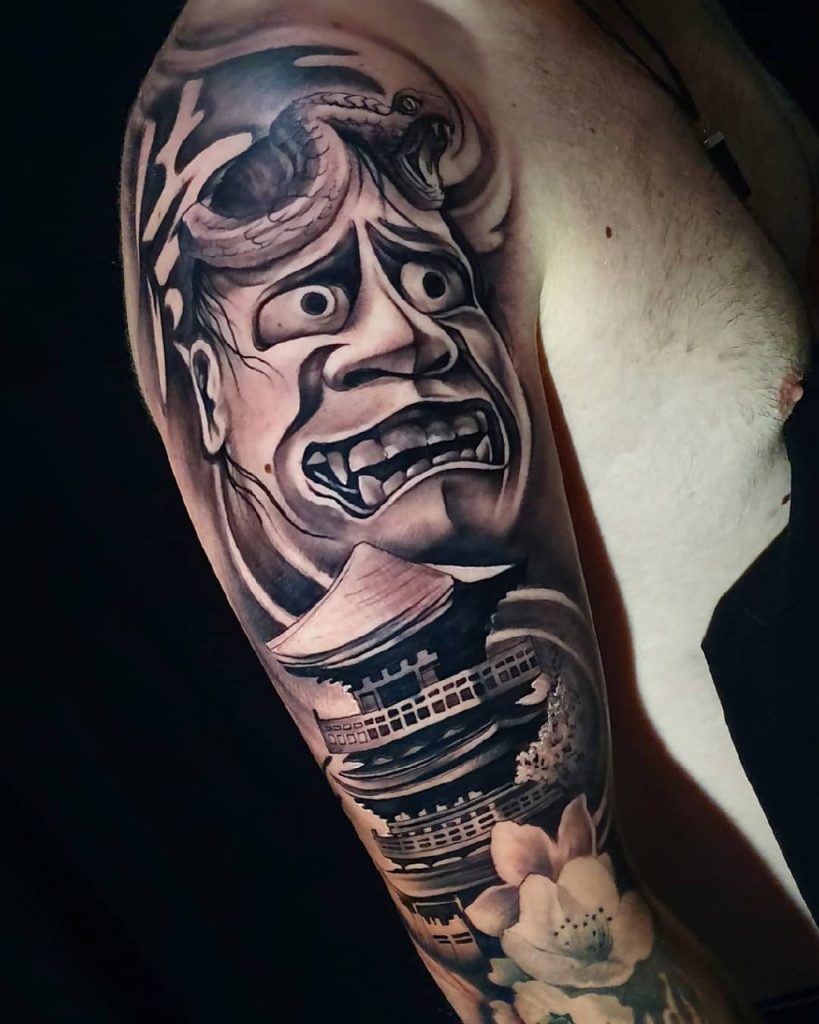
Японские маски и их значение
В мифологии Японии демонические существа увлекали грешников в ад и запирали их там навсегда. Рисунки отрицательных существ наносятся на тело для заимствования их магических способностей, поскольку в мифологии у них легко восстанавливаются потерянные конечности. Также им свойственны острый ум и недюжинная сила, поэтому они считаются мощным оберегом для людей.
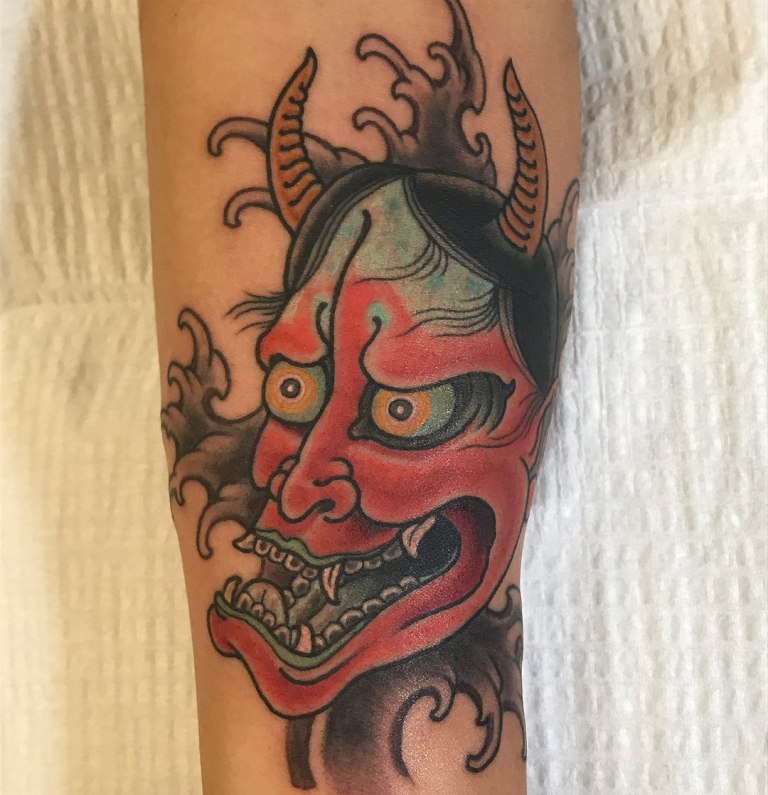
Для японских масок характерны яркие оттенки.
Самыми распространенными изображениями татуировок японских масок считаются те, которые разобраны ниже.
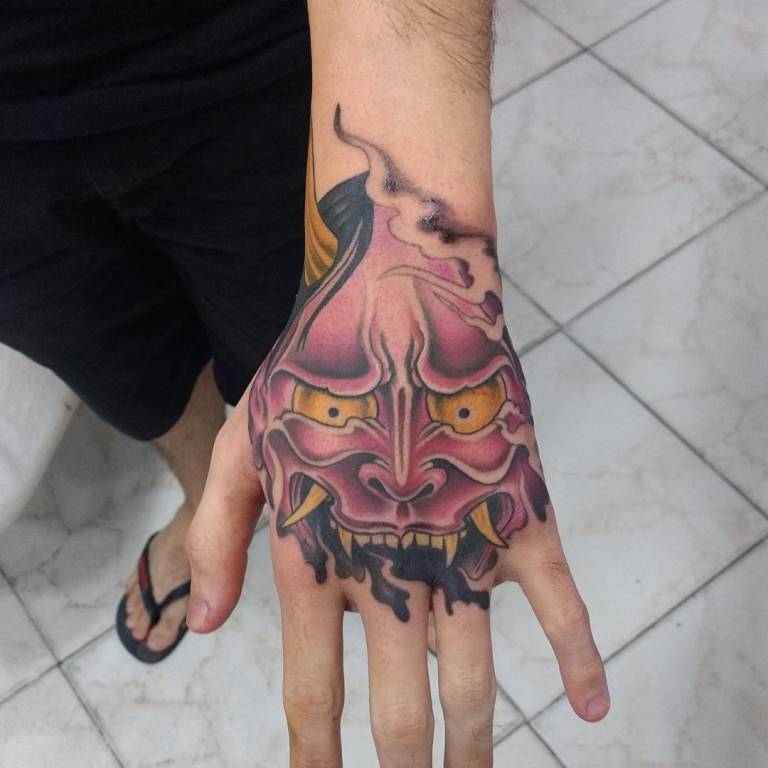
Демон Они. Это злобное человекоподобное существо, обладающее рогами и клыками. Его практически невозможно убить, так как отрубленные части тела отрастают заново. Тату Они выполняют охранную функцию, защищают добрых людей и наказывают недостойных.
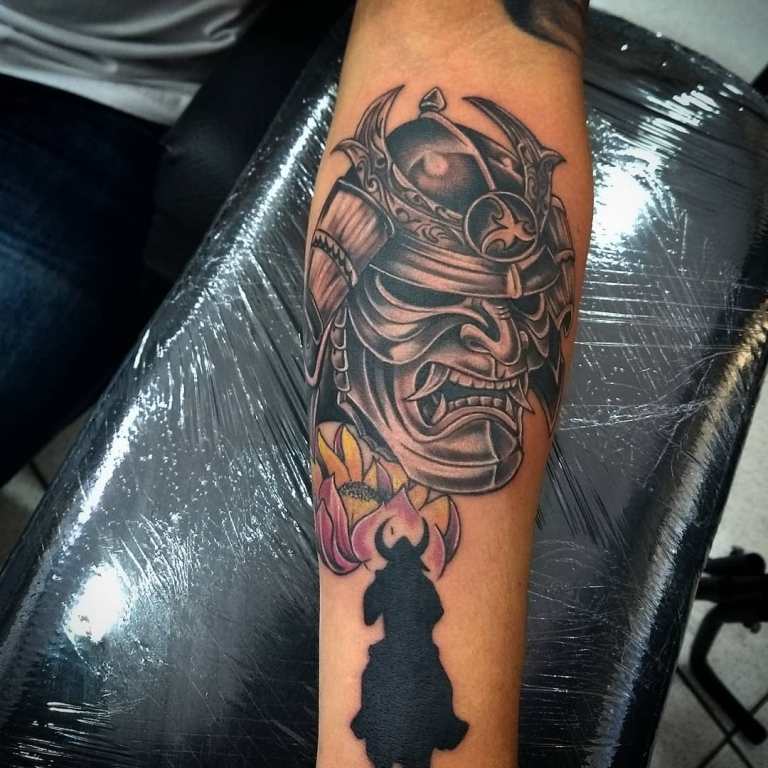
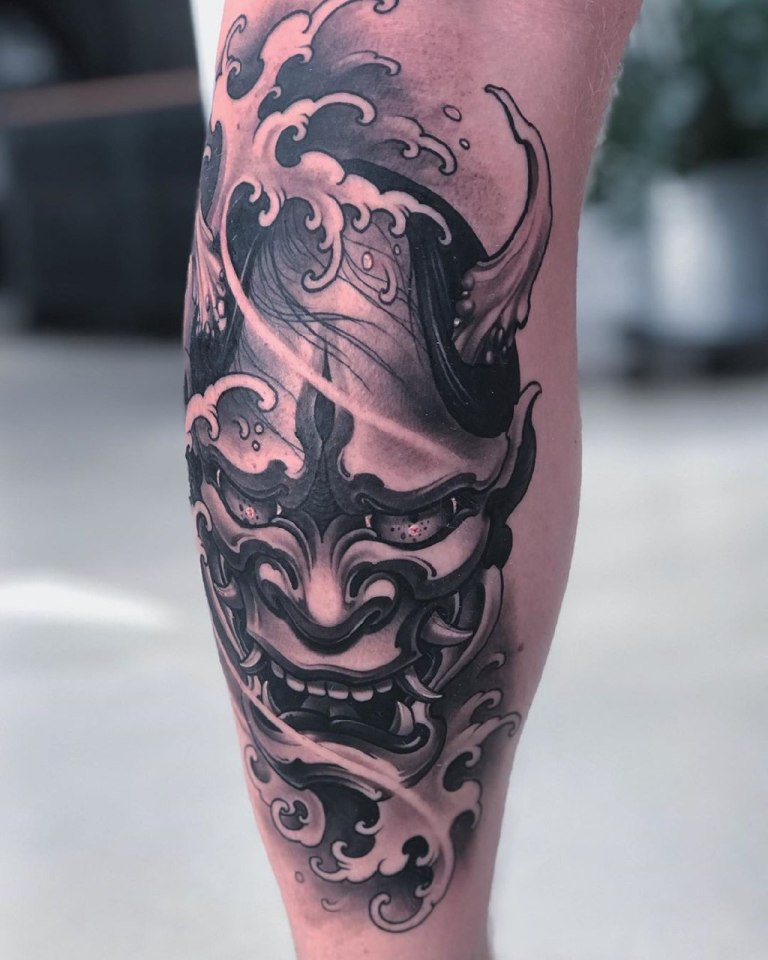
Демон Ханья. Представляет собой существо с рогами и клыками. Японская мифология считает, что в него превратилась мстительная и ревнивая женщина. Однако на татуировках изображается не в отрицательном значении, а в переводе обозначает «мудрость». Тату маски Ханья сильный оберег, отделяющий своего носителя от злых существ.
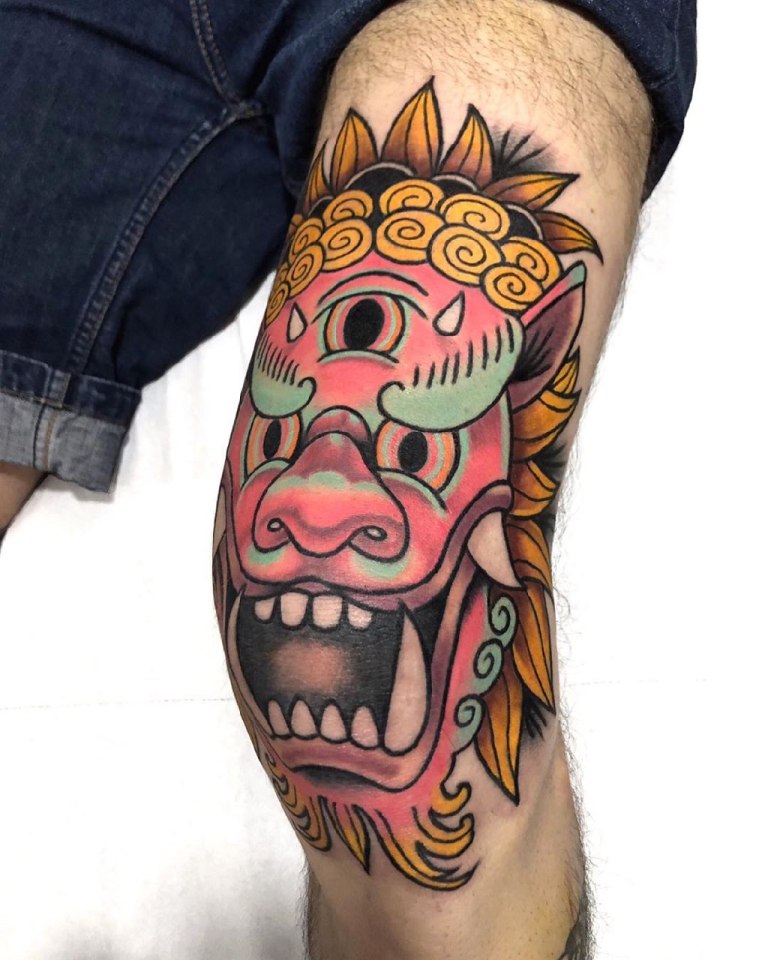
Маска Ханья — надежная защита от злых духов.
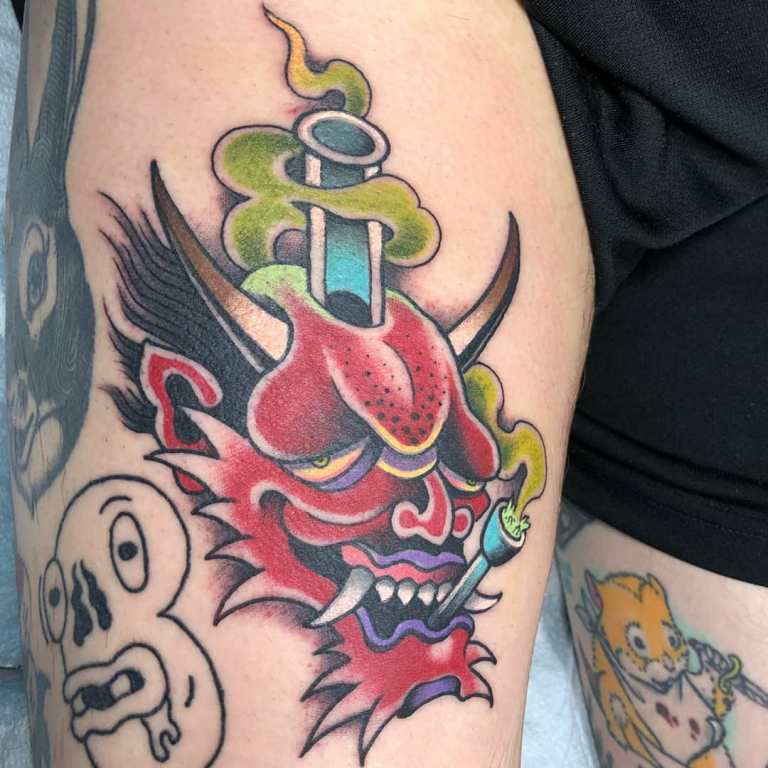
Маска демона Тенгу. Выделяют 2 разновидности Тенгу: Карасу-Тенгу и Ямабуси-Тенгу. В Первый изображается в виде ворона, а второй больше похож на человека. Ямабуси-Тенгу — человекообразное существо с красным лицом, длинным носом, а также иногда изображается с крыльями. Его можно сравнить с лешим, однако он больше помогает хорошим людям и наказывает тех, кто причиняет вред лесу.
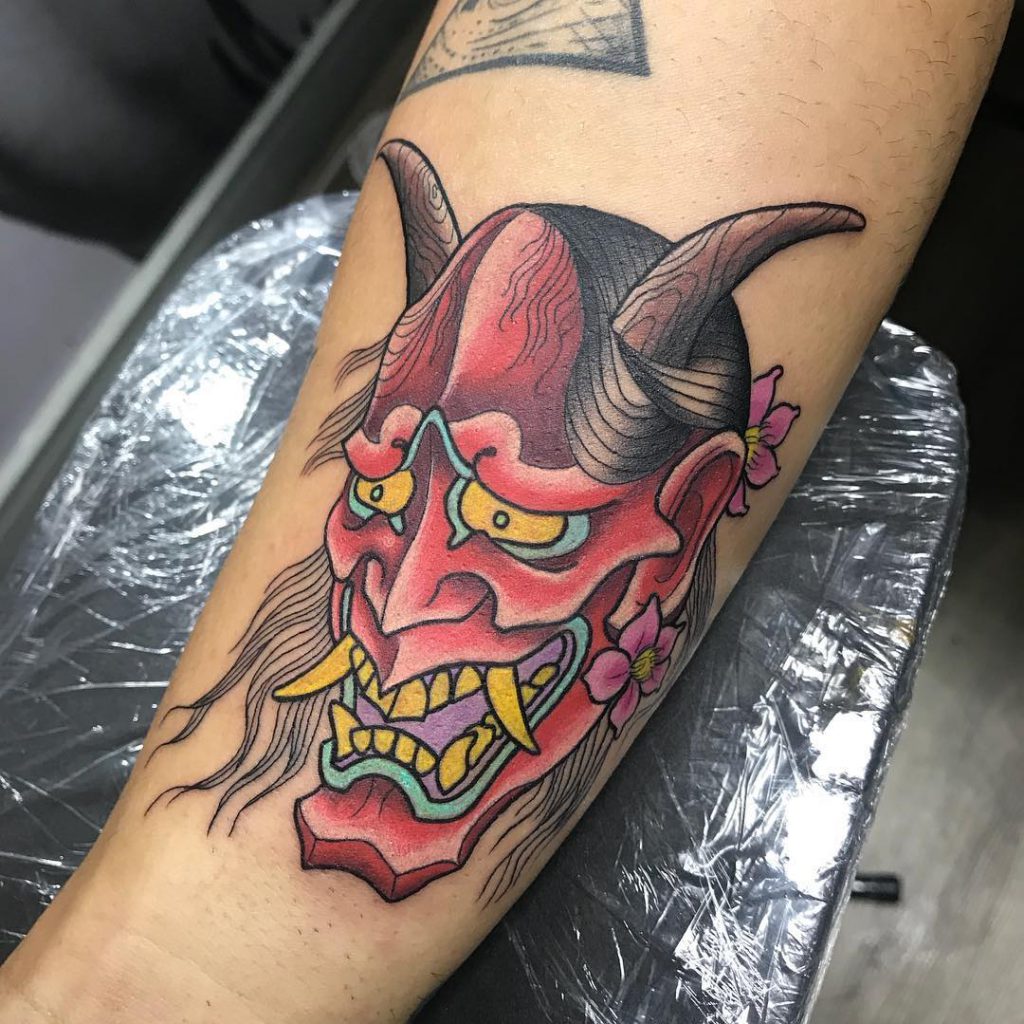
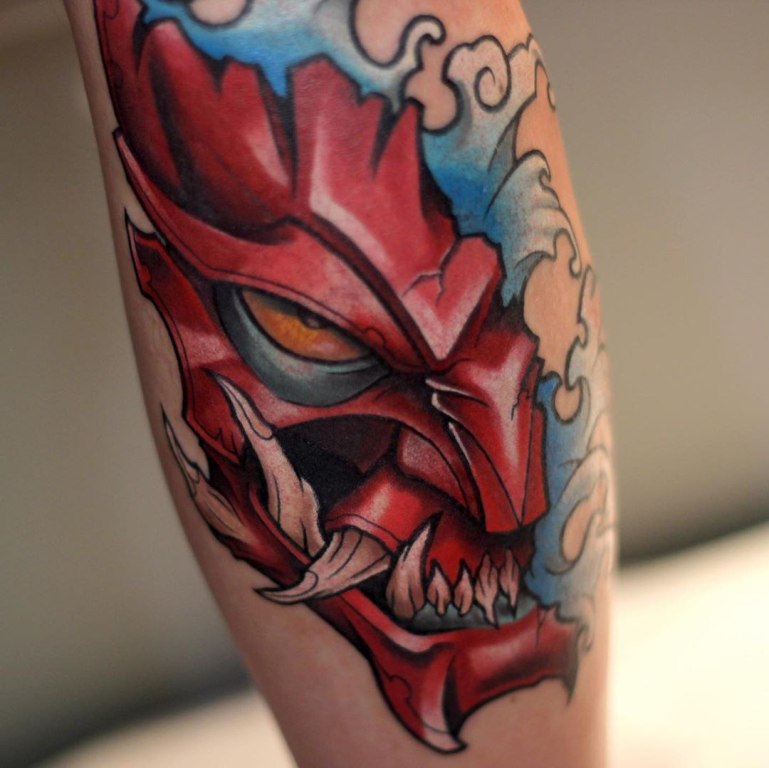
Тату дьявол. Мрачная зловещая сила, изображаемая с долей юмора и озорства. Эскизы наносятся в виде демона или черта. Популярный сюжет для мужских татуировок. Может изображаться с вилами или молотом. Это тату символизирует зависть, зло, коварство, грехопадение и душевную смерть.
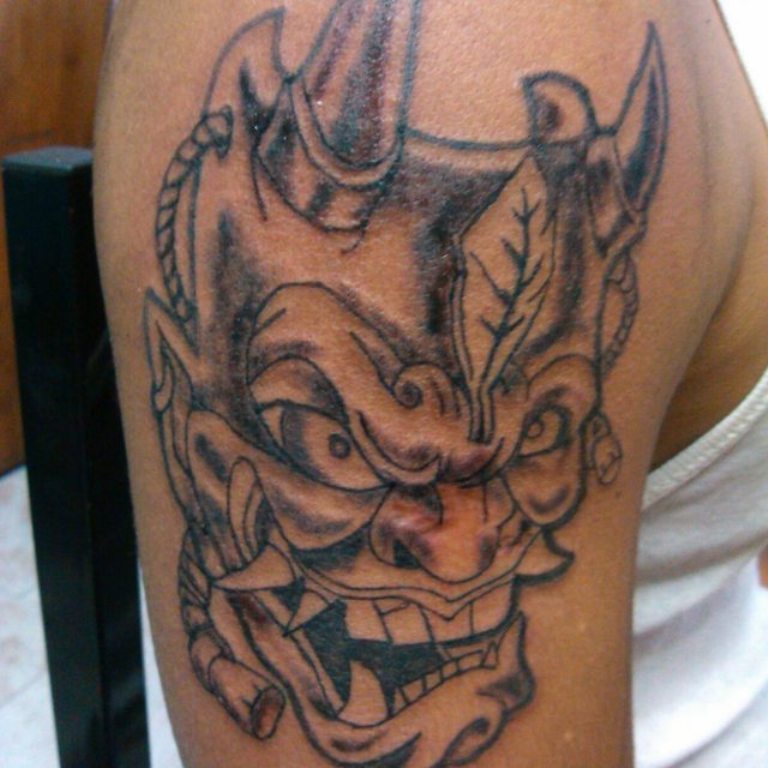
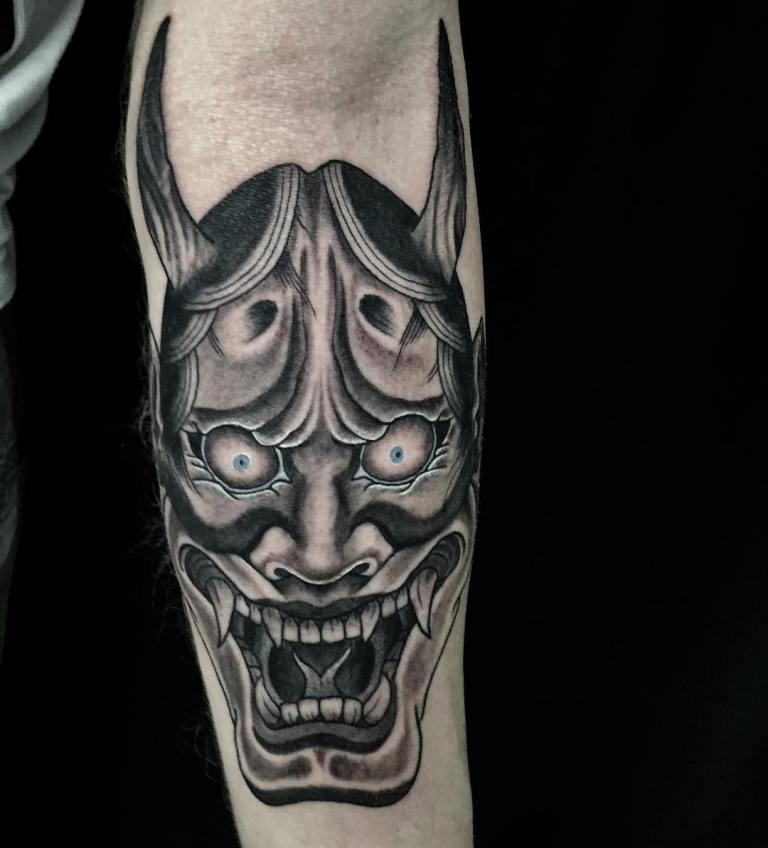
Помимо представленных татуировок популярными изображениями выступают изображения Бога грома Радзина, Ондэко-мена, Якшу, Рокурокуби, Кицунэ и т.д.
Тату демон: значение
Значение тату демон не относится к устрашающим символам. Татуировка демон является олицетворением большого количества соблазнов и искушений, с которыми человек борется каждый день.
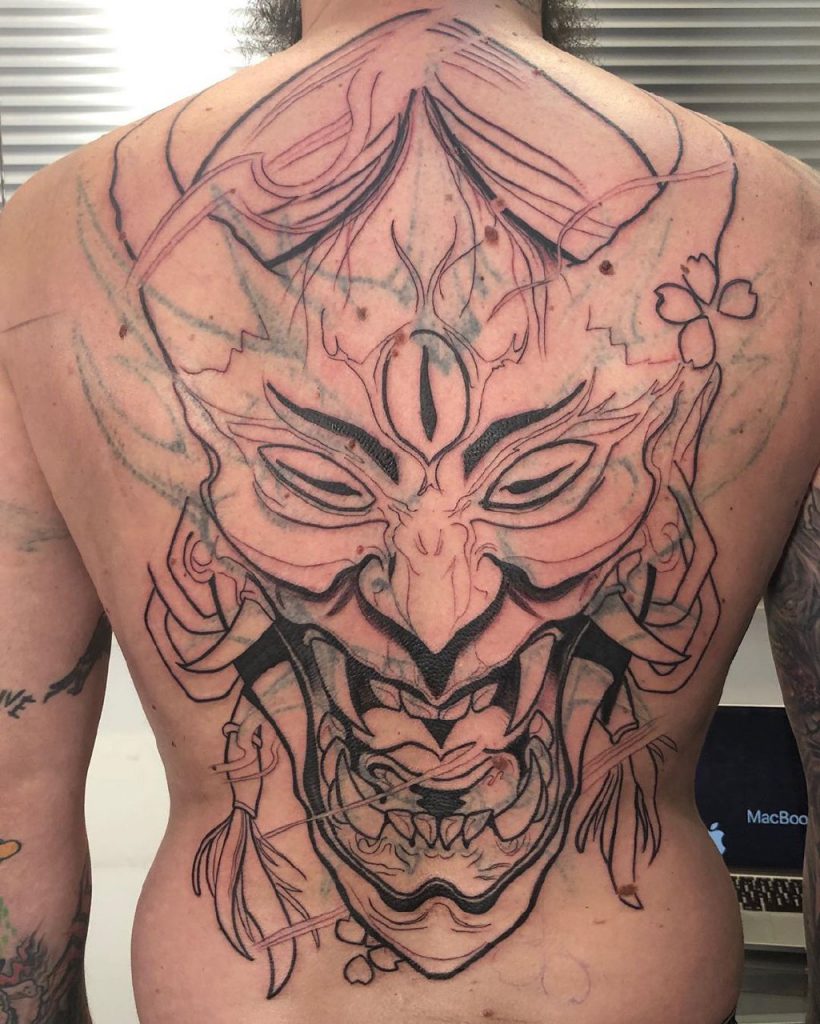
Во многих культурах демонические тату — это знак того, что человек знает о постоянных проделках темных сил и готов бороться с ними. Нанести рисунок демона на тело — это символ власти над злом, победа над влиянием демона и первобытное начало собственного сознания. Для лучшего подчеркивания сакральности татуировки используются темные цвета.
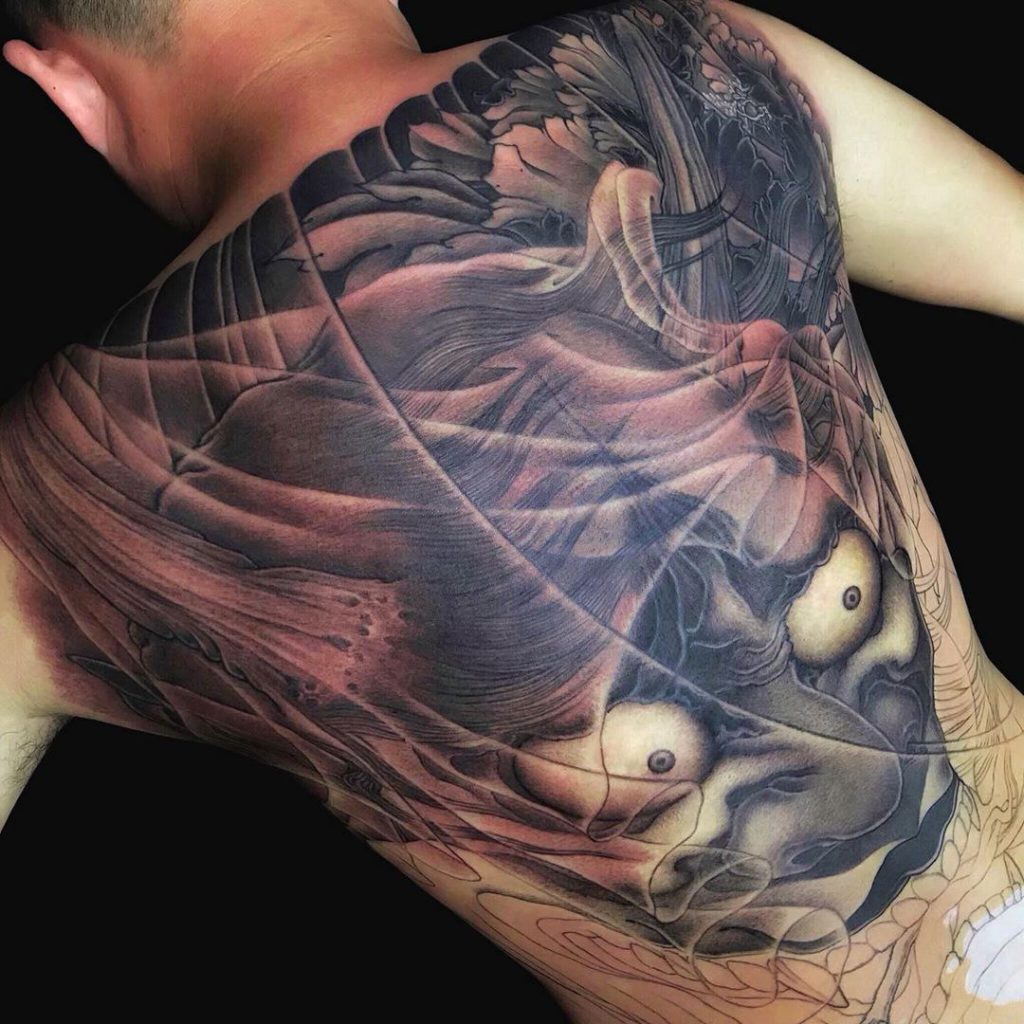
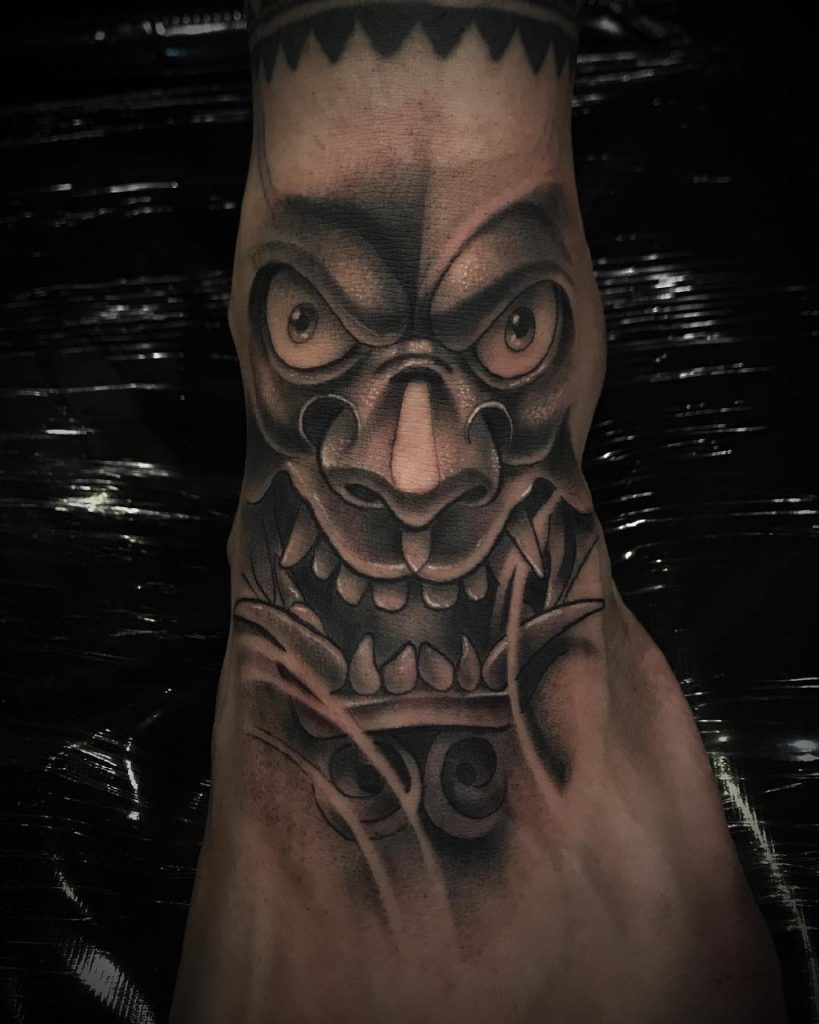

Тату демон в качестве оберега выбирают сильные и целеустремленные люди. Отрицательная сила существа не является ключевой. Рисунок стимулирует людей больше думать об избегании слабостей, уныния и не отчаиваться после первых неудач в задуманном деле.
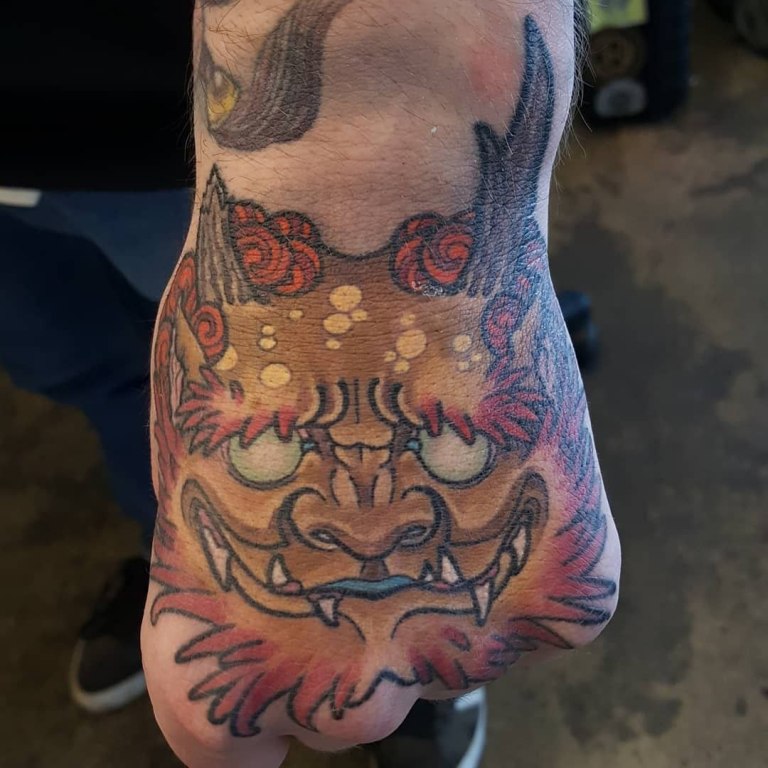
Динамичные позы в тату выделяют бунтарскую сущность обладателя, противостояние с обществом и общепринятыми ценностями. Часто подобными знаками пользуются сатанисты и некроманты.
Лучшие места на теле для тату демона
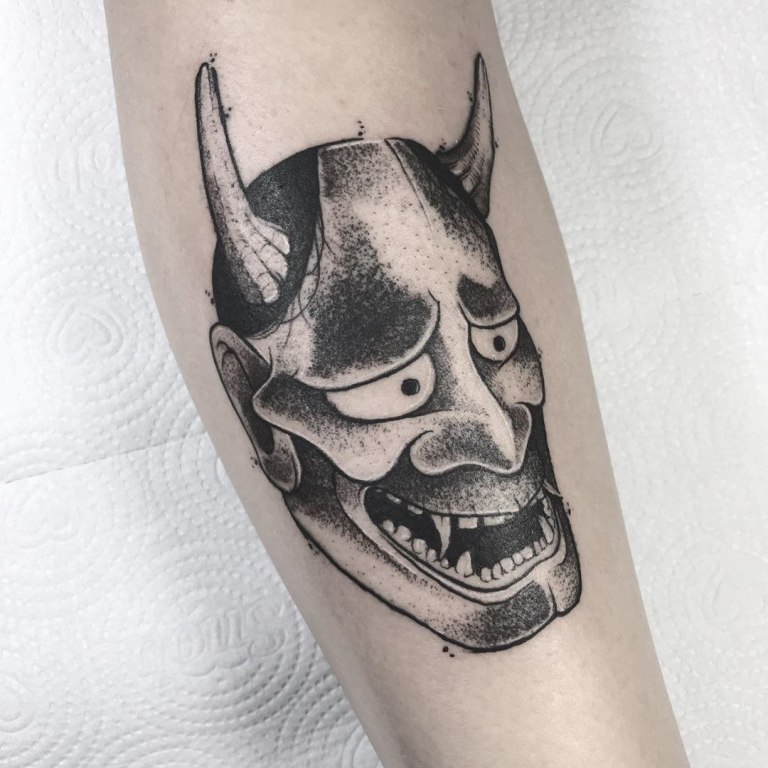
Наиболее часто татуировки с изображением демонов рисуются на:
- спине;
- плече;
- предплечье;
- руке;
- шее;
- груди и ключице.
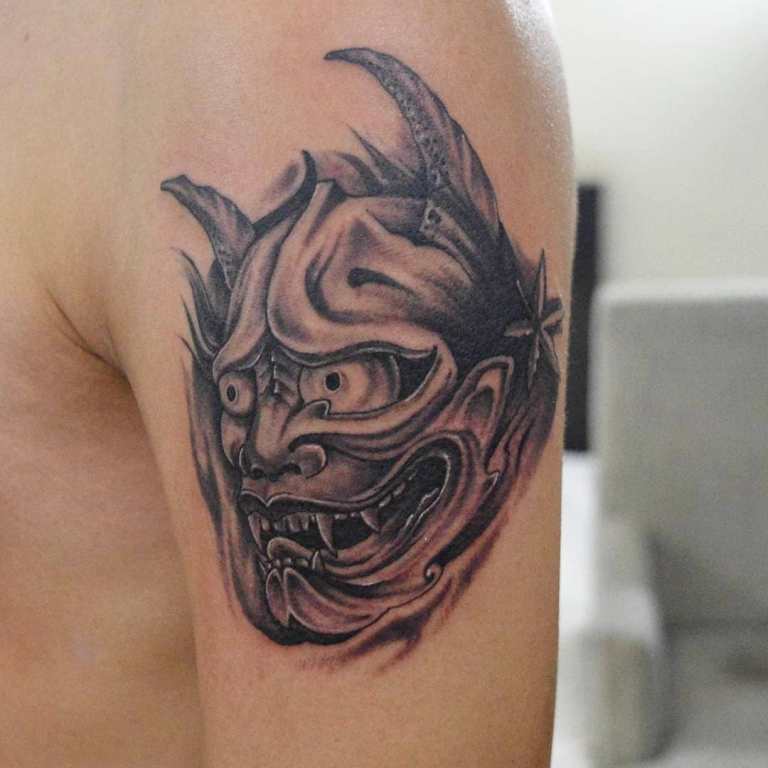
Эффектно смотрятся тату демона в крупном выражении четко прорисованные по всей руке. Ярко будет выглядеть демонический образ на груди или бедре. Существа в полный рост лучше всего смотрятся на спине, но многие парни предпочитают делать тату на голени.
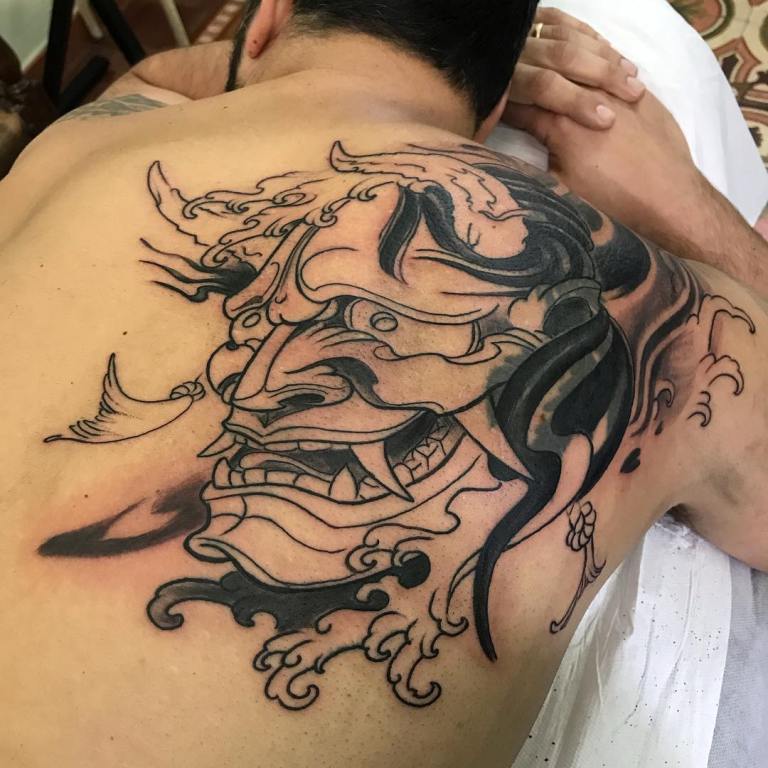
Эскизы тату демонов
Женщины часто выбирают для нанесения тату изображение Суккуба. Этот существо склоняет людей к занятиям с ним плотскими утехами. Зачастую изображается с миловидной женской внешностью и идеальной фигурой. Обладательница такой татуировки обретает сексуальную свободу, вызывает желание и похоть.
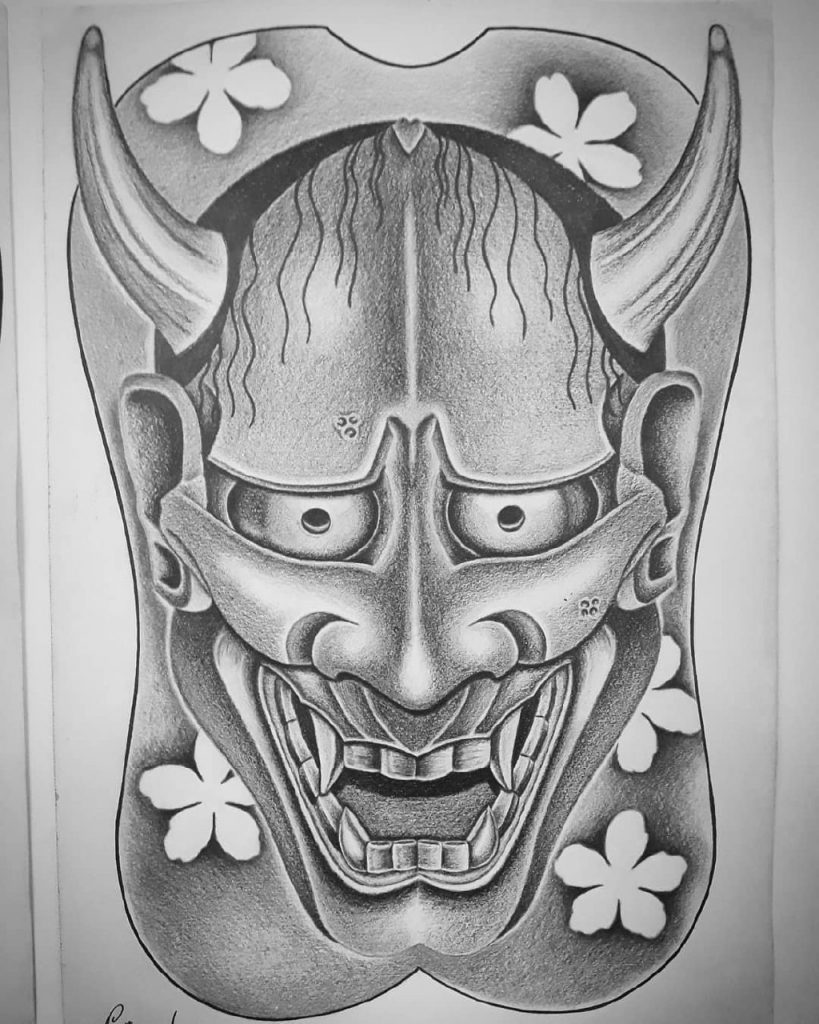
Данные мотивы пользуются наибольшей популярностью по всему миру.
Маленькие тату, доступные глазу привлекают внимание к их хозяйке, которая овладела внутренним демоническим началом, но не потеряла при этом остроумия и желания к развлечениям.
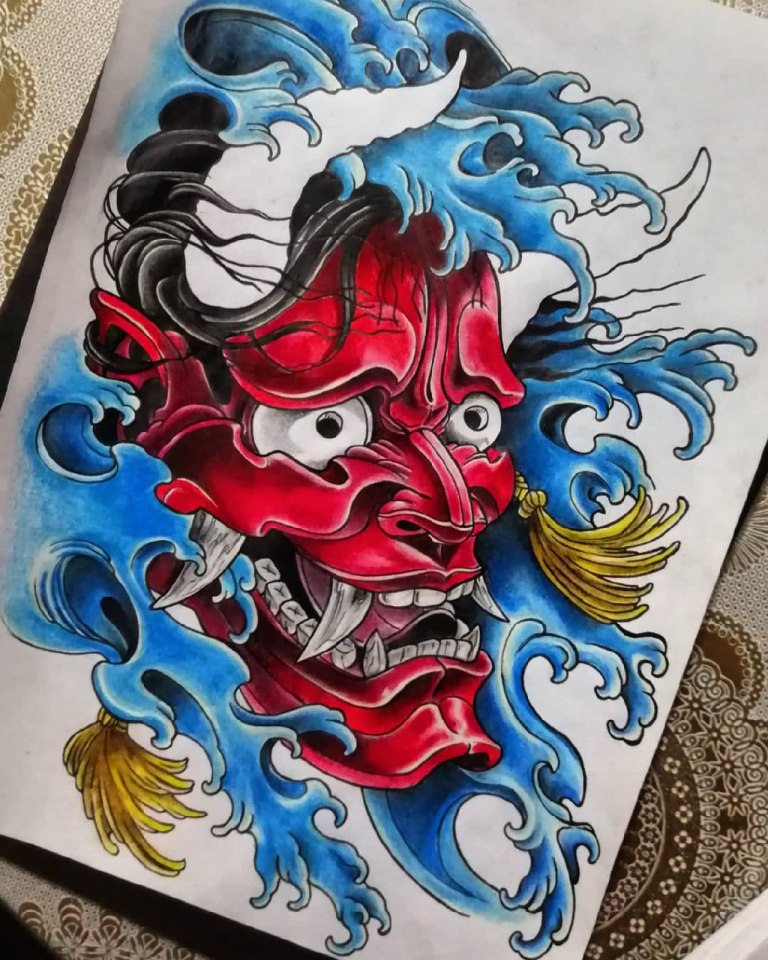
Мрачные и даже зловещие изображения на теле женщины сообщают о циничном и беззастенчивом характере. Это не всегда отрицательно для девушки, поскольку этот скорее говорит о ее прямолинейности, нежели о грубости и пошлости.
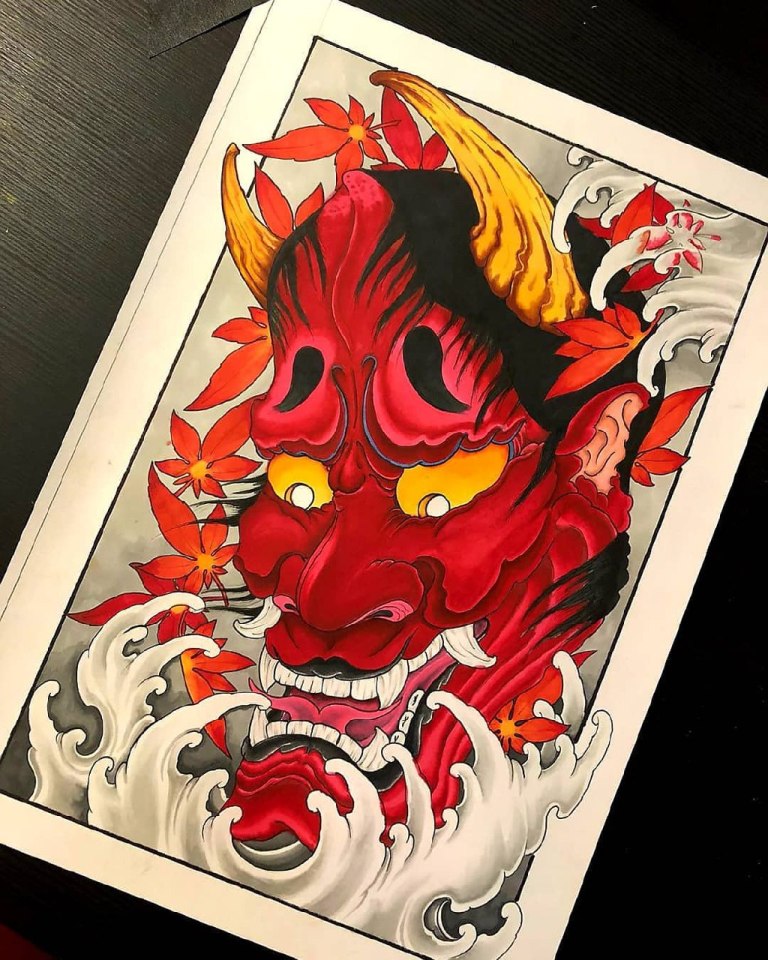
Мужские татуировки японских демонов набивают те парни, которые:
- не хотят воспринимать жизнь всерьез;
- легко поддаются соблазнам и падки на азартные игры;
- редко проводят время с пользой.
Изображение означает укор своей личности, либо служит оправданием слабости. Символ равнозначно соответствует как сильным, так и слабым сторонам мужского характера.
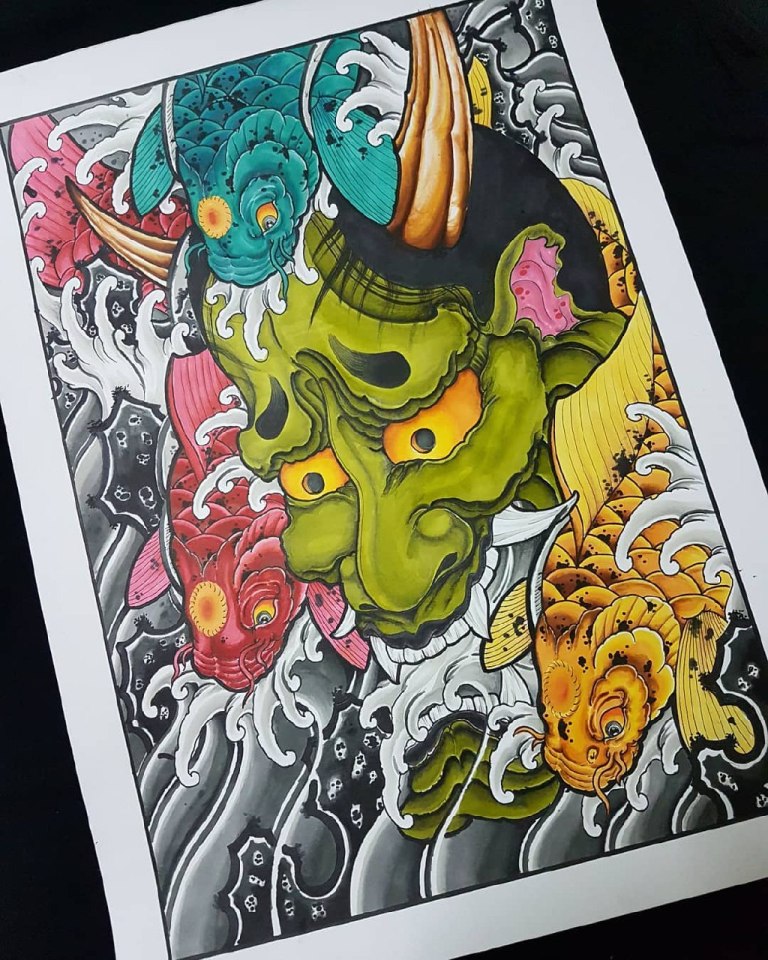
Надеемся, что представленные эскизы тату помогут вам сделать лучший выбор для будущего рисунка.
Эскизы тату маска Ханья
Ниже представлены самые популярные эскизы, которые помогут облегчить выбор будущего рисунка.
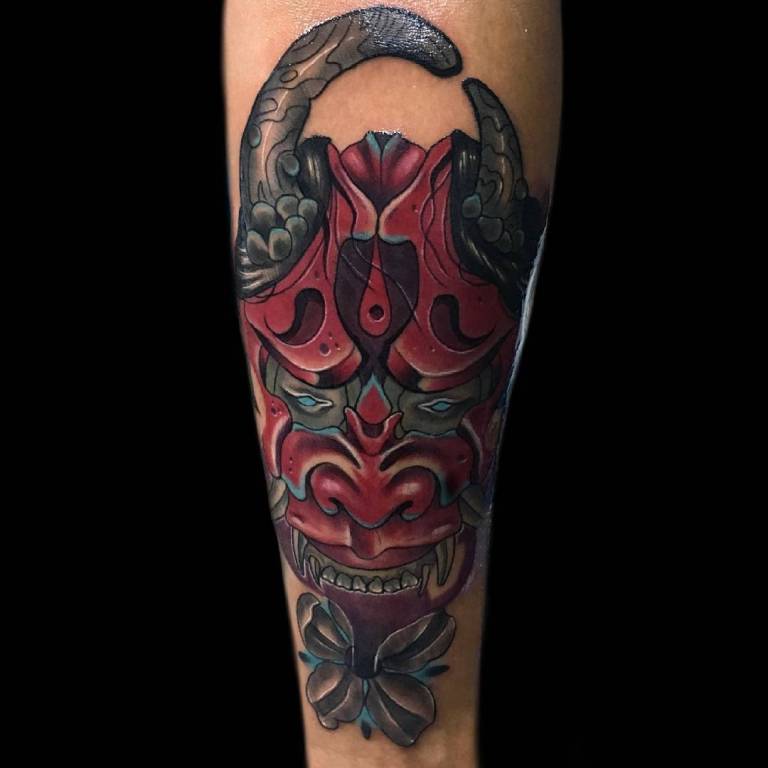
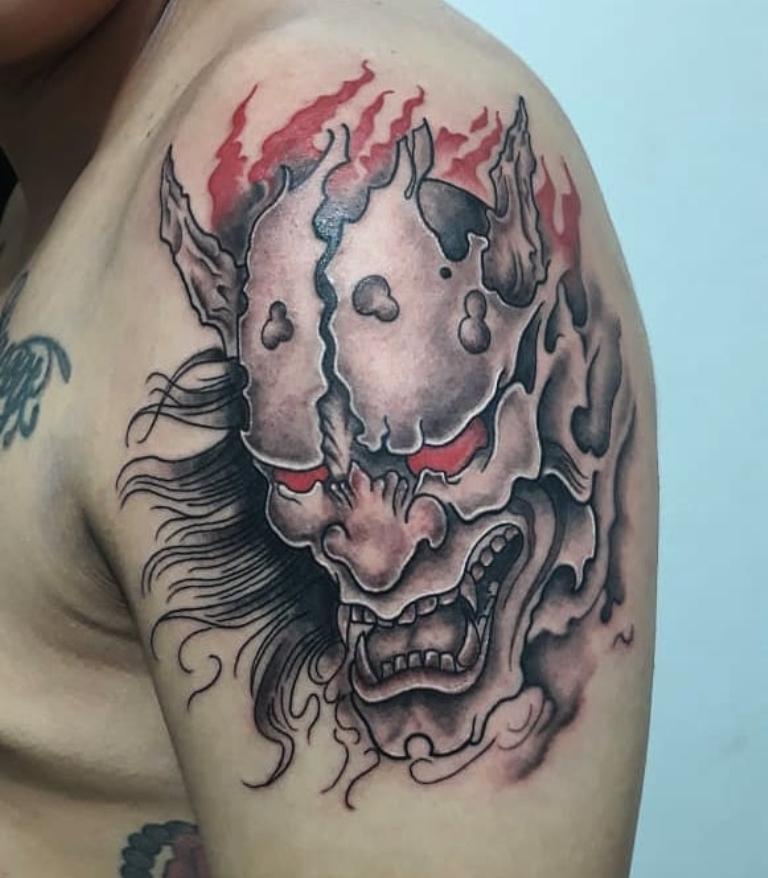
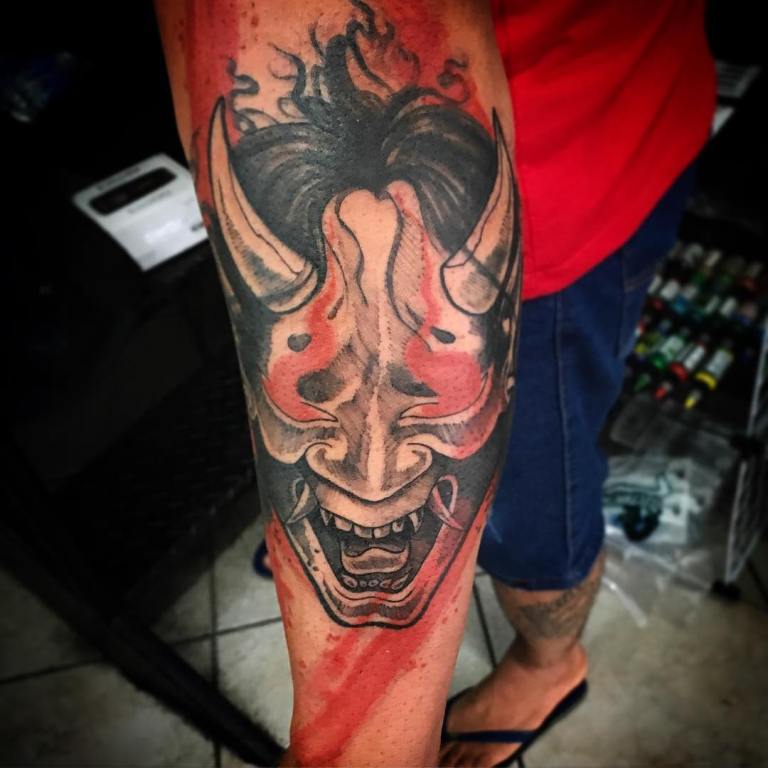
Фото тату с японскими масками и демонами
Представленные фотографии тату японских демонов и масок демонстрируют рисунки во всей красе. Можете лично в этом убедиться, просмотрев подборку.
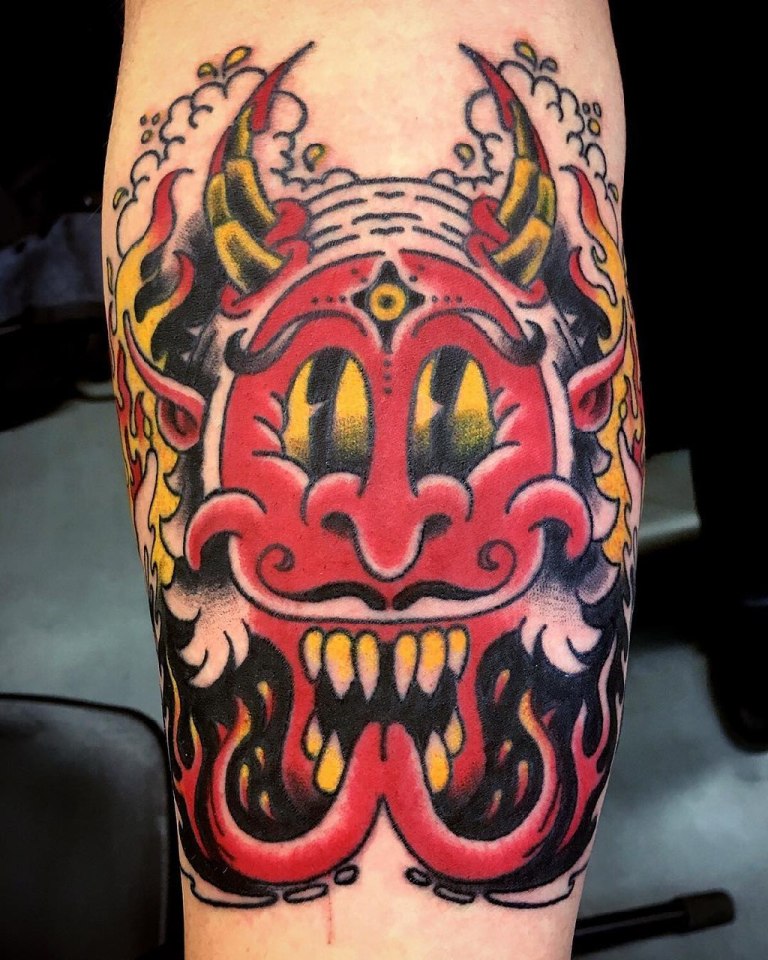
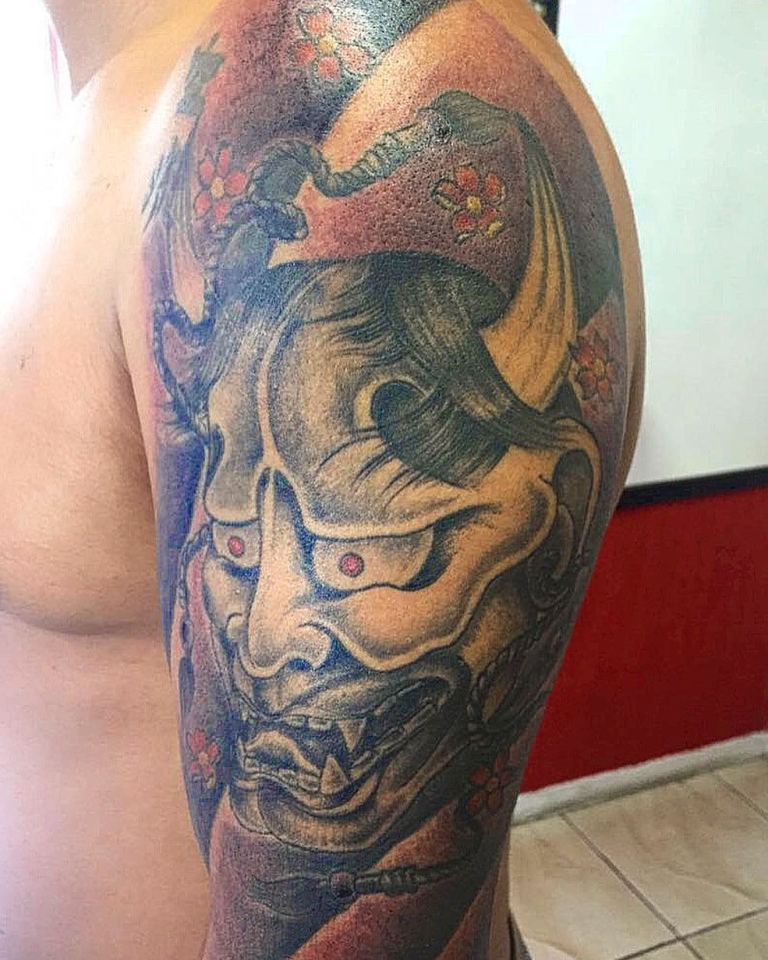
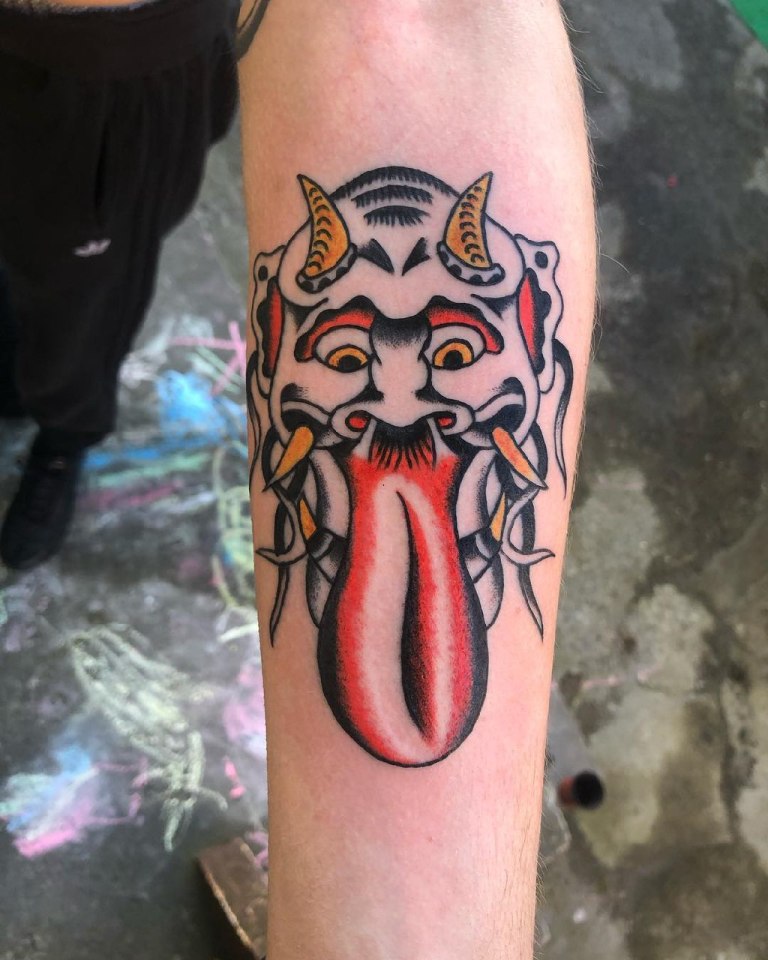


Татуировка японская маска — Ханья
Татуировки с изображением японских масок достаточно распространены и делают такие тату достаточно часто. В основном все японские тату маски это изображение демонов, духов, но в японской мифологии, татуировки с изображением масок демонов почитали и они считались оберегами от злых духов для своих хозяев которые носят татуировки с изображением японских масок.
Мы расскажем вам про значение татуировки с изображением маски Ханья.
Маска Ханья — одна из японских масок, которая обозначает мстительную, ревнивую и злую девушку, которая превратилась в демона. Причина её превращения – отсутствие взаимности со стороны её возлюбленного – монаха путешественника. Ханья означает разрушительное дыхание страсти. В соответствии с историей, девушка – демон нашла своего возлюбленного человека и сожгла его огненным дыханием.
Татуировка с изображением этой маски очень распространена среди японских жителей. Ханья – это маска с двумя рогами, которые похожи на рога быка. Рот всегда открыт от уха до уха, в нём большие ровные зубы и торчащие клыками. Её демонические глаза, цвета металла, всегда смотрят искоса, взгляд холодный и агрессивный. Внешний вид маски очень хорошо запоминается и быстро узнаётся. Слово Ханья, в переводе с японского языка, означает мудрость. По легенде, маска была создана монахом скульптором Ханья – бо.
В японском фольклоре маску использовали в театральных представлениях. Она обозначала женщин, которые превращались в монстров из-за ревности к своим любимым мужчинам. Самураи Страны Восходящего Солнца использовали маску Ханья в качестве оберега, они верили в то, что даже падшие ангелы будут их защищать в битвах.
Многочисленные демоны, монстры, оборотни, существа нечистой силы в культуре Японии всегда почитаемы, по их мнению, татуировки в таком стиле всегда являются сильными оберегами и амулетами, аналогами ангелов-хранителей, оберегающими владельцев тату. Вместе с маской Ханья чаще всего изображают колокол или змею.
Значение масок в японских тату

Тату с изображением японских масок имеют значение двойственности, таинственности. Мастера выполняют яркие эскизы с тщательной детализацией узора. Заметна усиленная агрессивность, которую подчеркивают с помощью цветовых контрастов. Изображения опасных существ олицетворяет внутреннюю силу и возможность противостоять злу.
Тату с демонами
Главное значение тату с японскими масками в виде демонов – борьба с пороками человека.
Несмотря на устрашающий вид, такие рисунки говорят не о могуществе зла, а о слабостях людей. Демон символизирует искушения, которые испытывает человек.
Тату с маской Ханья
Еще в древности тату в виде маски демона Ханья считалась сильным оберегом. Самураи наносили ее на тело, чтобы защитить тело и душу от врагов.
Современное значение маски Ханья – обретение мудрости посредством обуздания страстей и пороков.
Для маски Ханья используют сочные цвета: красный, зеленый, черный, голубой. Демона изображают с двумя рогами и широко открытым ртом с острыми клыками. Глаза смотрят искоса. Эффекта жестокого и холодного взгляда добиваются цветом с металлическим блеском. Особое искусство – это выразить посредством тату сущность Ханьи как гневного, но при этом страдающего демона.
Маска Ханья популярна среди мужчин. Ее чаще всего наносят на плечо, предплечье и грудь.
Маски самураев
Чаще изображают воинов, реже выполняют тату масок японских самураев. Они выглядят устрашающе, тщательно детализированы для усиления эффекта. Маска обычно имеет густые насупленные брови и острые торчащие зубы.
Татуировка означает скрытность, желание действовать под прикрытием, но идти до победы. Изображение олицетворяет воина, который привык скрывать эмоции и чувства. Это образ силы, преданности, четности, отваги.
Тату с масками японских самураев выбирают мужчины, их наносят на спину. Воины не демонстрировали силу без надобности. На спине татуировка достаточно скрыта от посторонних взглядов.
Большие рисунки выполняют на бедре, животе, плече. Широко используется черно-белая и черно-серая гамма. Включения красного указывают на мужество и готовность к бою, синий и желтый подчеркивают сдержанность человека и спокойствие.
Мужчины выбирают татуировки с масками самураев, чтобы показать свое почитание жизненных устоев воинов. Подобное изображение на теле девушки означает готовность бороться за семью, а также ум и силу.
Другие публикации
Тату Ханья: значение, фото татуировки, эскизы
Краткое значение тату Ханья
Значения татуировки Ханья двояки: защитник и мститель, мудрый страж и хитрый демон, всепоглощающая страсть и горькие сожаления.
Значение татуировки Ханья
Прежде всего, демон Ханья или Хання очень запоминающийся яркий и образный персонаж. Особенно на теле красочное изображение Ханья будет выглядеть незаурядным.
В японской культуре демоны не являются строго отрицательными персонажами. Они скорее духи и несут защитную функцию. Ханью изображают в качестве оберега. Этот образ можно сравнит с ангелом-хранителем.
Сама театральная маска изготавливается таким образом, что с одной стороны выглядит устрашающе и гневно, а в ином ракурсе отражает страдание, муку и сожаления, кажется рыдающей безутешно. Это требует особого мастерства исполнения. Ханья олицетворяет страдающую душу, осуществившую месть, но не нашедшую покоя.
История возникновения образа
Праобразом японского демона считается тибетский страж, хранитель буддизма мудрый Ханнья, обладатель маски змея.
С японской маской связана иная легенда. Девушка полюбила странствующего монаха, полюбила страстно и самозабвенно. А он взаимностью не ответил, продолжив свои скитания. Девушку объяли обида, гнев и злоба, за пренебрежение искренним чувством. Чувства
Маска Хання – это один из многочисленных видов масок, которые используются японскими актерами в театре Но. Маски передают настроение и характер различных персонажей.
Острые рога, сверкающие глаза, клыки, в сочетании с выражением ненависти,
обиды, страдания символизируют очень сильные эмоции.
В тату искусстве маска Хання является причудливым и привлекательным образом,
который часто используется в качестве элемента большой композиции. Иногда маска
изображается как самостоятельный образ.
По одной из легенд корни изображения маски Хання лежат в маске змеи. Хання –
мстительная злобная женщина, ставшая когда-то демоном из-за своей необузданной
ревности. Строго говоря маска Хання – это душа такой женщины.
Основными эмоциями маски являются гнев и возмущение. По другой версии ее
лицо изображает отчаяние. Но можно сказать также, что маска изображает
рыдания.
Отличительная особенность маски Хання – рога. В современном значении в
Японии два пальца, приставленных к голове, символизирующие рога, означают, что
женщина сходит с ума по мужчине или является большой ревнивицей.
То в какие цвета окрашена маска, имеет значение. Красные, бордовые, багровые
цвета указывают на сильное негодование и гнев. Более бледные цвета указывают
больше на отчаяние, неразделенную любовь. Но стоит иметь ввиду также, что цвет
указывает на классовые различия. Красный – душа женщины низкого сословия,
белый- женщина из аристократических кругов, багровый – собственно цвет
демона.
Маску Хання наносят как мужчины, так и женщины. В отличие от татуировки
демона Они, который лучше подойдет только представителям сильного
пола, Хання не имеет четко выраженного мужского или женского
стилистического начала. В качестве татуировки ее можно трактовать как
справедливый гнев, умение постоять за себя и свои ценности, отстаивать свое
мнение.
Часто маску Хання наносят без определенного смысла, а просто отдавая дань
уважения и любви к красивой японской мифологии и культуре Страны восходящего
солнца.
90000 Japanese Hannya Tattoos: Origins, Meanings & Ideas 90001 90002 Japanese Mask Tattoo 90003 90004 The Hannya is undisputedly one of the more popular subjects used in Japanese-themed tattoos. Designed with devil’s horns, somber eyes, and a wide mouth, the mask looks terrifying, formidable, and full of character. Veiled behind that sinister sneer is a fascinating backstory and a couple of interesting tidbits you may not have known. 90005
90002 Hannya Mask Meaning 90003 90004 90009 Note: 90010 The Hannya is sometimes confused with oni mask tattoos and kabuki theater face painting.90005
90012 History 90013
90004 The Hannya mask is used in Japanese noh and kyōgen theater shows (classical musical performances based on Japanese folklore and the supernatural). The mask represents a tormented female demon overtaken by jealousy and contempt. One of the most popular plays that utilized the Hannya mask tells the story of Prince Genji, who was married to Lady Aoi but had a mistress named Lady Rokujo. When his wife became pregnant, Prince Genji started to ignore Lady Rokujo. As a result, Lady Rokujo turns into a immensely jealous woman and is overcome with violent anger.With blinding rage, she transforms into a demon and possesses the wife and kills her. 90005
90012 Origin of the word «Hannya» 90013
90004 The word Hannya is thought to have come from the artist, Hannyabô, who carved this wooden mask. The design is believed to have been adapted from earlier serpent masks. Another theory is that «Hannya» comes from the word «Paññā / Prajñā» (般若), 90019 90020 which means «wisdom» or «higher consciousness» in Japanese Buddhism. 90005
90002 Hannya Mask Tattoo Meaning 90003 90004 Because the mask was traditionally designed to change expressions depending on the angle at which it was viewed, a Hannya tattoo design could represent the different stages of emotion.90005
90026 90027 90009 Anger, Jealousy, Resentment: 90010 A Hannya tattoo may indicate that the wearer is unforgiving. It is for this reason that the tattoo is so popular among the Yakuza (the Japanese mafia). A Yakuza member who wears this wants people to know that he shows no mercy and is a formidable force to be reckoned with. 90030
90027 90009 Pure Evil: 90010 If the mask is painted red, it indicates that the woman has lost control of herself and has turned into a demon completely.Someone who sports a red Hannya mask tattoo has probably gone too far over to the dark side. 90030
90027 90009 Passion and Love: 90010 The Hannya represents a woman that is overcome with intense and passionate emotions associated with love. The wearer might have had a history of unrequited love or betrayal. A Hannya tattoo could also represent someone who tends to give all of herself in a romantic relationship-all or nothing. 90030
90027 90009 Good Luck: 90010 In traditional Japanese culture, the Hannya symbol is used as a talisman to scare and ward off evil spirits and to bring good luck.Some superstitious people carry around a miniature Hannya mask on a keychain for protection, so getting a permanent Hannya tattoo on your body is a convenient way to take this talisman with you wherever you go. 90030
90027 90009 Judge of Good and Evil: 90010 The Hannya is the female version of the Oni (male demon). In Japanese folklore, the Oni punishes people by spreading disease. This may explain why the Hannya mask tattoo is popular among yakuza gang members as they often punish their enemies.90030
90027 90009 Wisdom: 90010 Because the word Hannya is a Japanese term for «wisdom,» hannya mask tattoos are a reminder to the wearer to be prudent in their romantic relationships. 90030
90027 90009 Tormented Female Spirit: 90010 The Hannya is a symbol of the human struggle between good and bad-the Hannya is sad but becomes evil when she lets her sadness turn into resentful anger. The mask could be a representation of a woman who is perpetually haunted by emotional conflict. 90030
90027 90009 Haunted Past: 90010 If you have a memory that haunts you but serves as a valuable lesson, the Hannya tattoo could be a representation of that.Some people also believe that the Hannya could prevent the past from repeating itself. The tattoo could also symbolize a difficult and emotional period in your past that you have conquered. 90030
90027 90009 Theater: 90010 A performer of traditional Japanese plays might get this tattoo to symbolize their profession and love for theater and Japanese culture. 90030
90063
90002 Hannya Tattoo Colors and Their Meanings 90003 90004 You might have seen the Japanese Hannya mask in different colors.90005
90004 90009 Color Intensity 90010 90005
90004 One belief is that the deeper the color of a Hannya mask, the angrier or more malicious it’s supposed to be. 90005
90026 90027 A Hannya mask with a lighter complexion means that the wearer is not yet a demon. The horns are usually smaller too. A lighter-colored Hannya tattoo means that the wearer is still human but is experiencing turmoil beneath the surface. 90030
90027 A darker red represents someone who has already been through a hellish emotional past.90030
90027 A deep dark red is symbolic of someone who is filled with rage and is out for vengeance. 90030
90063 90004 Personally, I do not think the Hannya mask should be limited to just traditional colors. I’ve seen designs that range from the original white and red to blue, purple, green, yellow, black, or any other hue. The most important thing is that the tattoo conveys the intended mood and fits with the general colors used in the whole tattoo. 90005
90004 90009 Color and Social 90010 90009 Hierarchy 90010 90005
90004 If you want a more traditional Hannya tattoo, then the colors can represent social rank.90005
90002 Design Ideas for Hannya Tattoos and Their Significance 90003 90004 Regardless of where your preferred placement is, be it a sleeve tattoo, a back piece, a calf tattoo, or a hikae tattoo, figuring out the complexity of the design will determine the size you should allocate for your ink. To have a very elaborate Hannya tattoo on a small area might cramp the overall design with too many things. 90005
90004 Plan for the components you want and your artist should do the layout for you.90005
90026 90027 90009 Tidal Waves: 90010 Like the Hannya, waves are unpredictable. Both the Hannya and the wave can be destructive, but they can also have moments of calm solitude. 90030
90027 90009 Chrysanthemums: 90010 Flowers are popular designs that are often incorporated into tattoos of this Japanese devil mask. Because this flower blooms in fall, and fall is the season of change, a Hannya chrysanthemum tattoo represents an anguished person who desires to escape their emotional state.90030
90027 90009 Sakuras / Cherry Blossom: 90010 Cherry blossoms represent life after death or illness. A Hannya cherry blossom tattoo is symbolic of achieving a better life after dealing with a tormented past. 90030
90027 90009 Maple Leaves: 90010 Leaves are symbolic of the cycle of life. The maple leaves and the mask could represent someone with an emotional past who hopes for a better future. 90030
90027 90009 Snake: 90010 This one is popular with the yakuza. In Japanese culture, the snake represents good luck and protection.In Ancient Japanese culture, the snake represented immortality. Hence, a snake Hannya mask tattoo could be a symbol of good luck, or it could mean that the wearer’s rage will never die. 90030
90027 90009 Skull: 90010 The skull is a positive representation of the life cycle. It is usually used to honor the dead. It could also represent the underworld and a demonic life. 90030
90027 90009 Koi: 90010 Because the koi swims upstream, this fish represents bravery, strength, and determination. Portrayed positively, a Hannya koi tattoo symbolizes bravery in the face of situations that may cause one to become jealous and vengeful.In a more negative light, the koi and Hannya mask could be a sign that the wearer is determined to wreak havoc. 90030
90027 90009 Dragon: 90010 In Oriental culture, the dragon is a benevolent creature that uses its strength to do good. A dragon tattoo with a Hannya mask symbolizes the struggle between using your power for hateful vengeance and using it to do good. 90030
90027 90009 Geisha: 90010 The geisha represents feminine power and intrigue. She is an enigmatic entertainment figure and can only be appreciated by certain people; thus she also represents someone who is unattainable.A Hannya mask and geisha tattoo represents a woman who is emotionally complex and unreachable. On a man, this combination could represent a woman in the man’s life who has similar traits. 90030
90027 90009 Samurai: 90010 The samurai is a symbol of strength and discipline, while the Hannya is a symbol of uncontrolled behavior. This is a fascinating contrast of concepts for a tattoo and could represent the eternal struggle between restrained and mindful thinking and untethered emotions that can cause harm.90030
90063
90002 Hannya Tattoo Styles 90003 90004 Besides traditional Hannya tattoos, which follow the irezumi style, many tattooists are injecting their personal twist. An example shown below preserves many of the Hannya masks ‘characteristics but also blends the illustrative style of Brothers Grimm’s Fairy Tales. 90005
90002 Oni Mask Tattoo vs. Hannya Mask Tattoo 90003 90004 There is some confusion as to the difference between these two Japanese mask tattoos. Both are used in traditional Japanese theater, but the difference is: 90005
90026 90027 The oni mask represents a male demon.90030
90027 The hannya mask represents a female demon. 90030
90063
90002 What Does a Hannya Mask Look Like? 90003 90004 The Hannya mask is a compelling sight of disheveled hair, two sharp horns piercing through the temples, huge bulbous eyes, and fangs showing from a gaping mouth split ear to ear. It is the perfect imagery of evil. 90005
90004 In noh theater, the contorted serpent face is to represent demonic feminine jealousy, with the Hannya meaning to show a «half demonic phase», to be followed by a «true serpent» or Shinja (真 蛇; 真 — real 蛇 — snake ).90005
90004 Although the mask features a seemingly perpetual scowl, when viewed at different angles, the Hannya shows varied humanized expressions. 90005
90026 90027 From the front, it looks menacing and filled with hatred. 90030
90027 Tilted at an angle and viewed from the top, it appears forlorn and anguished-almost crying. 90030
90063 90004 These array of emotions reflect the complexities of the human psyche. 90005
90002 The Story of Hannya and Unrequited Love 90003 90004 Legend has it that the Hannya was a beautiful woman who morphed into a grotesque demon due to jealousy, hatred, and vengeance.As they say, «hell hath no fury like a woman scorned.» 90005
90004 The most common story is that of a beautiful lady, Kiyohime, who fell deeply in love with a monk. Because she was unable to receive love in return, her heartbreak and negative emotions transformed and contorted her expressions into scary and exaggerated forms. Her painful expression portrayed both rage and misery. The monk was so frightened by her face that he ran towards a shrine and hid under a large prayer bell, which further infuriated the Hannya.90005
90004 When she found him cowering underneath the bell, she blew fire at it, effectively melting it and burning her lover alive. Her action sealed her own fate as a demon. 90005
.90000 What Does Hannya Mask Tattoo Mean? 90001
90002 When debating on getting a tattoo, there are many options out there. However, one of the oldest and most symbolic style of tattooing comes from the Japanese. Tattooing in Japan has been a long journey. From being accepted, to being outlawed, back to being accepted again. From dragons to cherry blossoms, there are a plethora of different symbols from Japanese lore. There are many images in Japanese tattooing that can be had but the one we are talking about today is the Hannya mask.90003
90002 In this post we will talk about the Hannya mask and where it originated. We will also talk about the symbolism behind the Hannya mask tattoo and what it means to those that choose to get this historical tattoo. Finally, we will go over some of the variations of the Hannya tattoo and talk about what changes, if any, the additional symbols add to the meaning of the Hannya tattoo. We hope by the end of this post you will have a better idea of the Hannya tattoo meaning and give you that little boost you might be looking for, so you can get your own.90003
90002 90007 What is a Hannya Mask? 90008 90003
90002 The Hannya mask is a traditional Japanese mask used in Noh theatrical performances, kyogen theatre and Shinto kagura dances. It is a representation of a jealous woman driven mad and transformed into a horrible demon. In a way she is similar to Medusa, but she has her own backstory and its roots are very much in Japanese culture. 90003
90002 90007 About the Hannya Mask Tattoo 90008 90003
90002 Why is the Hannya mask tattoo so popular? It’s pretty simple, really: It looks great! It is usually a larger tattoo, but some people will get a smaller Hannya mask with other designs surrounding it.Some people see it as a pretty creepy image, while others see it as just plain beautiful. Either way, it’s a striking image that has a number of different meanings. The Hannya mask meaning that each owner gets depends on who they are and the type of Hannya mask tattoo that they decide to get. 90003
90002 The mask features two sharp pointed horns, heavy, sorrowful eyes and a wide, screaming mouth. There are often pointed teeth as well, adding to the terror. The image is usually meant to frighten and horrify, causing the audience to fear the raging jealousy of the tortured demon woman.Someone who gets a Hannya mask tattoo might be trying to get a «wow» out of people who see it, or they think the image represents some part of themselves. 90003
90002 There are three degrees of Hannya masks, representing the descent of a tormented woman into the madness of jealousy and obsessive behavior. The twisted passions of love are shown as the woman is gradually transformed into a demon as her obsession for her lover overwhelms her. Some Hannya mask tattoos have multiple parts of this process in their Hannya mask, while others will just choose one of the images.90003
90002 The first type of mask is the lightest colored and the furthest away from the true demon. The horns are smaller and less menacing but still inhuman. When someone decides to use this Hannya mask image, they are usually expressing that they are still normal (or sane) at this point, but there is danger and chaos just below the surface. A person with anxiety or deep rage might find that this version of the Hannya mask is perfect for them. 90003
90002 The second mask is darker, a deeper red, that portrays a woman on the cusp of being overtaken by her jealousy due to unrequited love.A person who has gone through a very troubled relationship and is having a tough time with it might choose this type of Hannya mask. It could also be a tat for a woman who has been cheated and the scars have yet to heal. 90003
90002 The third mask is a vivid red and represents a true demon, a tortured and enraged soul that is unpredictable. The demons are to be greatly feared with their sharp, long horns and teeth. Their extreme misery leads them to murderous and cruel actions. This is the Hannya mask tattoo that most people choose, even if they are not crazy in any way.It is an iconic image that can be a huge tattoo on its own or mixed with other tattoo designs. 90003
90002 90007 Hannya Mask Symbolism 90008 90003
90002 The Hannya mask is a symbol of jealousy and unpredictable behavior. The tormented female spirit can not be trusted and can murder her lover if she can not be satisfied. The demon must be exorcised and banished from the material world to bring peace to her victim. When this Hannya mask is used, the owner is often trying to get past a tough moment in their lives (often a bad relationship) and they use the tattoo to remind themselves to keep looking forward.90003
90002 The mask is a representation of a haunted past. It portrays the unjustly placed obsession of a twisted and miserable soul that can not be satiated. The image of the mask commemorates the slaying of this demon and the marking of its place left in the past. This Hannya mask tattoo meaning is equally popular with both men and women. The mask can represent just about any dark moment in one’s past and the owner can think of the Hannya as keeping it from coming back to the surface. 90003
90002 90007 Hannya Mask Tattoo Variations 90008 90003
90002 The Hannya mask is a very common design in Japanese tattooing and is a powerful image on its own.However, some people choose to add some other symbolism or images with the Hannya mask tattoo to either reinforce the symbolism or change it slightly. Below are a few examples of the Hannya mask tattoo. 90003
90002 90007 Hannya Mask and Cherry Blossom Tattoo 90008 90003
90002 The Hannya mask and cherry blossom tattoo is a common mix of symbols in a tattoo. The cherry blossom is a symbol of life being beautiful and also fleeting at the same time. Because cherry blossoms are extremely beautiful but die fast, they symbolize that life is short and beautiful.The mixing of these two might not seem to make sense, however, it might be a way to help your jealous tendencies calm when you understand that you do not have time to feel that way. 90003
90002 90007 Hannya Mask and Snake Tattoo 90008 90003
90002 The Japanese snake symbolizes the divine feminine or attributes of the female that might be holy. This fits right in with the duality of the female. The jealous and unpredictable side of the woman versus the beautiful feminine part of a woman. This tattoo is a beautiful image of the different spirits of a woman and seems to be a popular choice for Japanese tattoo enthusiasts.90003
90002 90007 Hannya Mask and Water Tattoo 90008 90003
90002 The Hannya mask tattoo and wave tattoo symbolize the ebbs and flows of life in all its forms. This even relates to women and the feelings of jealousy. In addition, the Japanese waves are great filler for most Japanese tattoos when you are looking to fill those gaps between the big images of Japanese Irezumi. 90003
90002 The Hannya mask tattoo is one of those tattoo designs that does not need multiple meanings to be a fantastic design tat choice.It looks great in both color and black and gray, so it’s the type of design that plenty of people would love to have. Yes, it’s a bit creepy to look at initially, but it can also hold a very powerful meaning to its owner and can be further customized to work with their tastes. 90003
90002 Thinking about getting a Hannya mask tattoo? Then be sure to look over multiple design options before you commit to it. You can get a large Hannya mask tattoo on your back, or you could get it on your arm with other images surrounding it.90003
90002 We also suggest taking your time when looking for an artist to complete your Hannya mask tattoo. When you are looking for your artist, make sure they are well versed in the art of Japanese tattooing because you do not want to end up with someone that is going to wing it. Go on their social media accounts and look at their portfolios when you go in to talk to the artist. If you are having trouble finding someone to make your vision come to life, let us know. The team at Tattoo SEO has years of experience in matching customers to the perfect tattoo artist.Happy hunting! 90003
90002 90067 90068 90069 90068 90071 90068 90073 90068 90075 90068 90077 90068 90079 90068 90081 90068 90083 90068 90085 90068 90087 90068 90089 90068 90091 90068 90093 90068 90095 90068 90097 90003.90000 Hannya Mask Tattoo — The History and Meaning 90001
90002 What is the meaning behind a Hannya mask tattoo? 90003
90004 Asian art has always held an esteemed place within the tattoo industry in Downtown Toronto and Vancouver. Imagery linked to ancient Japanese mythology is one of the most popular subjects for tattoos at Chronic Ink Studios in Toronto. 90005
90004 Not only are Japanese style tattoos beautiful, they are also often filled with rich symbolism and history.Today we’d like to dive deeper into the history and meaning behind one of the staples of Japanese style tattoo art, the Hannya mask (sometimes confused with the Oni mask and Kabuki theatre face painting). 90005
90004 90009 90009 90005
90002 The history of the Hannya mask 90003
90004 This imposing and formidable looking mask most closely resembles a demon on first glance, however, its actual origins and story goes much deeper. To fully understand the Hannya mask, we need to travel back to the 14th century.The Hannya mask first appeared in a well-known variety of traditional Japanese musical theatre known as «Noh Theatre» which was popular around this time. The actors in Noh plays would tell stories through gestures while adorned in intricate masks. 90005
90004 The Hannya mask was used in Noh plays to depict a woman who has become so overwhelmed with sorrow, envy, or rage that she takes on the form of a demon, dragon or serpent. Its prominent features are a leering mouth, sombre metallic eyes, sharp fang-like teeth, and two devil style horns.90005
90004 90019 90019 90005
90004 One of the most popular plays to feature the Hannya mask tells the story of Prince Genji, who is married to Lady Aoi but has a mistress named Lady Rokujo. When Prince Genji’s wife becomes pregnant, he ignores Lady Rokujo. Lady Rojuko becomes overwhelmed with jealousy and violent anger after losing the affections of her lover and transforms into a demon who possesses the wife, eventually leading to her death. 90005
90002 Hannya mask meanings and symbolism 90003
90004 The mask itself represents female rage and pain and is demonic, angry, frightening, and dangerous while at the same time tormented, heartbroken, melancholic, and sorrowful.Depending on the angle the physical mask is being held, the expression will seem either angry or sad. Overall, the idea behind the Hannya mask is to represent the intense emotions that can be brought to the surface when an otherwise calm and wise woman is betrayed or scorned. 90005
90004 Though the overall story and appearance of the mask may seem dark, the word Hannya in Japanese actually means «wisdom» and the masks themselves are considered a symbol of good luck. In Japan today, the masks are often used as a means of warding off evil.90005
90004
90002 Our Favourite Tattoo Aftercare 90003
90005
90034 After Inked 90035
90004
After Inked Tattoo Moisturizer delivers effective skin moisturization and helps to preserve the colours of your tattoos. There’s no petroleum so it will not stick to or stain your clothes. This moisturizing skin lotion, enriched with Grape Seed Oil, can also be used on any permanent makeup procedure on lips, brows, eye liner, and areola, as well as an after-laser tattoo removal moisturizing lotion.After Inked is Dermatologist tested, non-allergenic and non-irritating.
90005
90004
Get Yours Today
90005
90034 PurSan 90035
90004
PurSan Aftercare is a specially formulated Vegan skin cleanser used to clean and moisturize as part of an aftercare regimen for fresh tattoos and piercings. It revitalizes, refreshes and purifies skin without drying it out. Gentle yet effective, PurSan contains no parabens, fragrances, colourants or alcohol. Chloroxylenol (PCMX) is a proven antimicrobial ingredient shown to be effective against bacteria and viruses without burning or irritating the skin.Hydroxypropyl Methylcellulose (Hypromellose) is an ultra-high grade lubricant ideal for sensitive skin.
90005
90004
Get Yours Today
90005
90002 The Hannya mask in tattoo form 90003
90004 The base meaning behind the Hannya mask is open to many individual and personal interpretations, this is likely one of the reasons the Hannya mask has been such a popular subject for Japanese style tattoos throughout the years. 90005
90004 The myriad of meanings behind the original Hannya masks can take on a variety of forms when portrayed in a tattoo.Extreme vibrant colours can be used to emphasize specific emotions that you want to highlight or black and grey tones may be chosen to invoke the feelings of melancholy which are also present. 90005
90004 Choosing the positioning and angle of the mask in your tattoo will also determine the overall emotion that is displayed, in much the same way that holding the original masks at different angles drastically changes the expression. 90005
90004 In addition to playing around with the colours and angles of the mask itself, working with your tattoo artist to come up with the ideal design to surround your Hannya mask tattoo can further deepen the meaning you wish to portray.Combining the Hannya mask with other Japanese imagery is a popular choice, as most Japanese imagery holds deeper meanings and pairs well stylistically with the mask making for really striking large-format tattoo pieces such as sleeves and back pieces. 90005
90002 90057 90057 90003
90004 What style of Hannya mask would you get in tattoo form? Would yours represent jealousy and rage or sorrow? Perhaps yours would play more on the aspects of wisdom and good luck, warding off these more negative emotions.90005
90004 No matter what you envision when picturing a Hannya mask tattoo, our experienced artists at Chronic Ink Tattoo would love to collaborate with you to bring your vision to life! 90005
90002 Excited to Get your Hannya Mask Tattoo ?? 90003
90004 What style of Hannya mask would you get in tattoo form? Would yours represent jealousy and rage or sorrow? Perhaps yours would play more on the aspects of wisdom and good luck, warding off these more negative emotions. 90005
90004 No matter what you envision when picturing a Hannya mask tattoo, our experienced artists at Chronic Ink Tattoo would love to collaborate with you to bring your vision to life! 90005
90004 Tell us Your Idea 90005
90004 Downtown Toronto 90005
90004 378 Yonge Street, 90075 2nd Floor, 90075 Toronto, Ontario 90075 M5B 1S6 90075 Directions 90005
90004 Midtown Toronto 90005
90004 252 Eglinton Ave East, 90075 2nd Floor, 90075 Toronto, Ontario 90075 M4P 1K2 90075 Directions 90005
90004 Markham 90005
90004 7381 Kennedy Road, 90075 Unit # 105, 90075 Markham, Ontario 90075 L3R 5B5 90075 Directions 90005
90004 Newmarket 90005
90004 Upper Canada Mall 90075 17600 Yonge Street, 90075 Newmarket, ON 90075 L3Y 4Z1 90075 Directions 90005
.90000 Japanese Hannya Mask Tattoos: Meaning & Designs 90001 90002 90003 Indomitable is our weekly series where we examine 90004 90003 various motifs in traditional Japanese tattooing (Irezumi) 90004 90003, while looking at work from some of the most talented tattoo artists in the world. 90004 90009 90010 The Origin and the Meaning behind the Hannya Mask Tattoos 90011 90002 Hannya masks are one the most popular archetypes in Irezumi and probably the most famous Japanese demon mask tattoos, but for as much as people fixate on their ferocious looks, their tragic origin in Japanese folklore all too often gets glossed over.These figures, with their bulging eyes and severe underbites, have been around since the Edo period in Japan, when they were portrayed by actors in Noh theatre. The myths surrounding these icons are heartbreaking and the meaning of the hannya mask is tragic: a hannya is said to be born when a woman grow so obsessive, jealous, and angry after being spurned by a lover that she transforms into an oni hell-bent on wreaking vengeance on unsuspecting men. 90009 90010 Join the Biggest Tattoo Community! 90011 90002 Find your next tattoo.Download the app. 90009 90002 Since its stage debut, the image of the hannya mask has spread into other traditional Japanese art forms — paintings, epic poetry, and other mediums, including tattoos. Whether it’s Lady Rokujo from 90003 The Tale of Genji 90004 or the «The Laughing Demon» by Katsushika Hokusai, every depiction of these cursed women has the emotional imprint of the artist who created it, and tattoos of hannya are no exception. 90009 90010 Artists who have designed amazing Hannya Mask Tattoos 90011 90002 All the artists featured here bring out the anguish and rage embodied by hannya masks in unique ways.Some capture the somber backstory of the sullen figures, rendering them with muted color palettes as seen in the pieces by Marius Meyer, Regino Gonzales, Damien Rodriguez, Caio Pineiro, and Hide Ichibay. Others tattooists, such as Mike Rubendall and Henning Jorgensen, celebrate the icon’s more colorful designs, which can be seen in the masks still worn in Noh performances to this very day. The most impressive hannya mask tattoos are often the large-scale ones. Johan Svahn’s and Mike Suarez’s massive compositions portray the inner turmoil and outward fury of these female demons perfectly.90009 90002 To see more examples of this cautionary symbol of obsession, jealousy, and anger, download our app and find countless Hannya mask design ideas. If you’re thinking about getting a tattoo of a hannya mask of your own, we recommend you commission a specialized artist near you to execute it. 90009 90002 90029 Updated at November 18, 2019 3:32 pm 90030 90031 First published at March 12 2017 3:53 pm 90030 90009 90034 90002 Written byRoss Howerton 90009 90002 BA in Literary Studies from The New School.MFA in Creative Writing from NMSU. Staff Writer for Tattoodo. I love art, books, movies, music, and video games. Hit me up on Twitter @Powertonium 90009.
